Electric pickup trucks have long found themselves in a bit of a weird place. Trucks like the Ford F-150 Lightning and the Rivian R1T have the guts and power to do some impressive hauling, but their short range means they’re impractical for all but the most local towing jobs. The Chevrolet Silverado EV is the antidote, being the first electric pickup with legs long enough for drivers to dare to tow long distances on electric power. The towing range is impressive in itself, but that range is also wrapped in a package so good at hauling that you might not want to buy a diesel. But there’s a catch, I think, and it’s that America just isn’t ready for people to tow long distances with electric trucks yet.
I had the privilege of testing a 2026 Chevrolet Silverado EV Trail Boss for a little longer than the duration of the 2025 EAA AirVenture Oshkosh aviation spectacular. I used this beast of a truck to tow a 7,746-pound, 36 feet, 9 inch long travel trailer approximately 133 miles in each direction. Then, I used the truck to get around Oshkosh, including brief stints going mudding in the fields around camp.
The Silverado was shockingly good at towing a trailer and had enough towing range that so-called “range anxiety” just wasn’t a thing for me. However, I had plenty of anxiety for another reason during this trip, and it was over charging stations. It wasn’t the availability of chargers, as there were plenty, but how they were designed without considering the future.

(Full Disclosure: General Motors loaned me a Chevrolet Silverado EV Trail Boss for a little over a week to do a road trip with. I received the truck with a 96 percent charge and paid for my own juicy recharges.)
The State Of Electric Hauling
First, I want to explain the state of electric pickup trucks and hauling. On July 30, I explained that when you’re towing a trailer, regardless of whether your tow rig is gas or electric, aerodynamics usually matter more than weight. Car publications and YouTubers love to talk about how they towed 6,000 pounds or 11,000 pounds with their electric pickup trucks. While these weights are impressive, they do not tell the whole story.
As Robert Dunn of Aging Wheels had proved with his independent testing, weight isn’t nearly as important as many people would think. A 1,500-pound trailer with a 12-foot-tall wall on its front will almost certainly result in your truck guzzling more battery or more gas than that same truck towing a 6,000-pound trailer that’s completely flat. Likewise, if you parked a car behind the giant wall of that first trailer, your fuel economy or range is unlikely to get much worse because the heavier hit wasn’t weight, but trying to ram something the shape of a brick through wind.
This is also why some of the most fuel-efficient cars on the planet practically slice through air. While weight absolutely has a huge importance in towing, from whether your vehicle’s structure can support the trailer to stopping distance, climbing performance, and more, aero and frictional drag are your main enemies for efficiency. If you don’t believe me, watch this:
This applies to my towing situation. It sounds impressive that I got the Silverado EV Trail Boss to tow a 7,746-pound, 36 feet, 9 inch long travel trailer so many miles on a single charge, but the real impressive part is that, as you can see with your own eyes, this trailer’s front wall towered over the Silverado EV and dragged it down in wind.
These findings are reflected in real-world towing testing. Back in 2022, Car and Driver made a Ford F-150 Lightning, a GMC Hummer EV, and a Rivian R1T tow the same 6,100-pound, 29-foot camper. The Ford had only 100 miles of towing range, or less than half of the 230 miles of highway range that it had when unloaded. The Rivian scored only slightly better with 110 miles of towing range against its 280 miles of highway range. The winner of the test was the GMC Hummer EV, which went only 140 miles against the 290 miles that it could do at the same speed while empty.
How about the Tesla Cybertruck? The Fast Lane Truck hitched a 7,500-pound camper and averaged 1.1 miles per kWh, which is actually pretty good efficiency while towing. However, even with that efficiency, it still would have resulted in a theoretical towing range of just 135 miles, and that’s driving the truck until it’s dead.
Honestly, this kind of towing range is pathetic for someone like me, who often tows big trailers over large distances. Stopping just over every 100 miles to charge for 30 minutes or longer would make any road trip a total drag. Certainly, it would be impossible for me to pick up a car from the Port of Baltimore and then drive the 773 miles back home on the same day.
This was pretty much the state of towing with an electric pickup truck for a while. All of these trucks are actually really good at towing, and their all-electric powertrains make pulling thousands of pounds feel like child’s play. But range and charging limitations mean that these trucks can never live to their full towing potential.
That was until the Chevrolet Silverado EV arrived on the market in the 2024 model year. It sounds like a cliche, but this truck changed the electric towing game.
Big Weight, Big Power, And Big Range
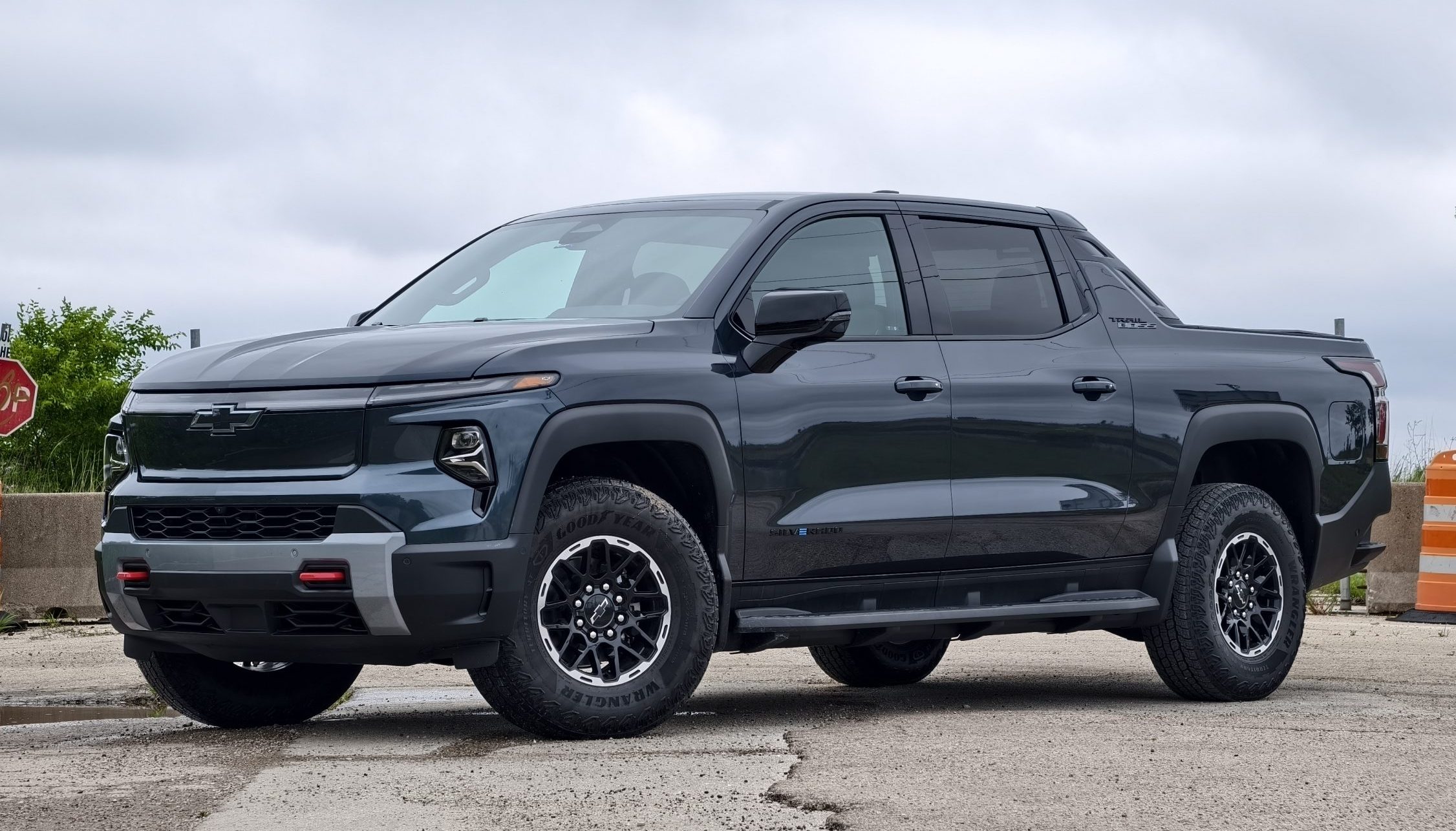
This was demonstrated in real life as both car publications and YouTubers started putting up towing range figures large enough to make you do a double-take. The guys of The Fast Lane Truck hitched a 6,000-pound enclosed cargo trailer to a Silverado EV and managed to get 230 miles of range out of the truck. Zack of JerryRigEverything hooked 11,000 pounds of trailer and Humvee up to a Silverado EV and got 177 miles of range – not bad. Robert Dunn from earlier has been using his Silverado EV like any truck owner would, taking it on long-distance trips and making it work just as hard as a gas truck.
I just got to experience the Silverado EV myself, and my experience mirrors theirs. But why? How does the Silverado EV manage to do what other electric pickup trucks have not?
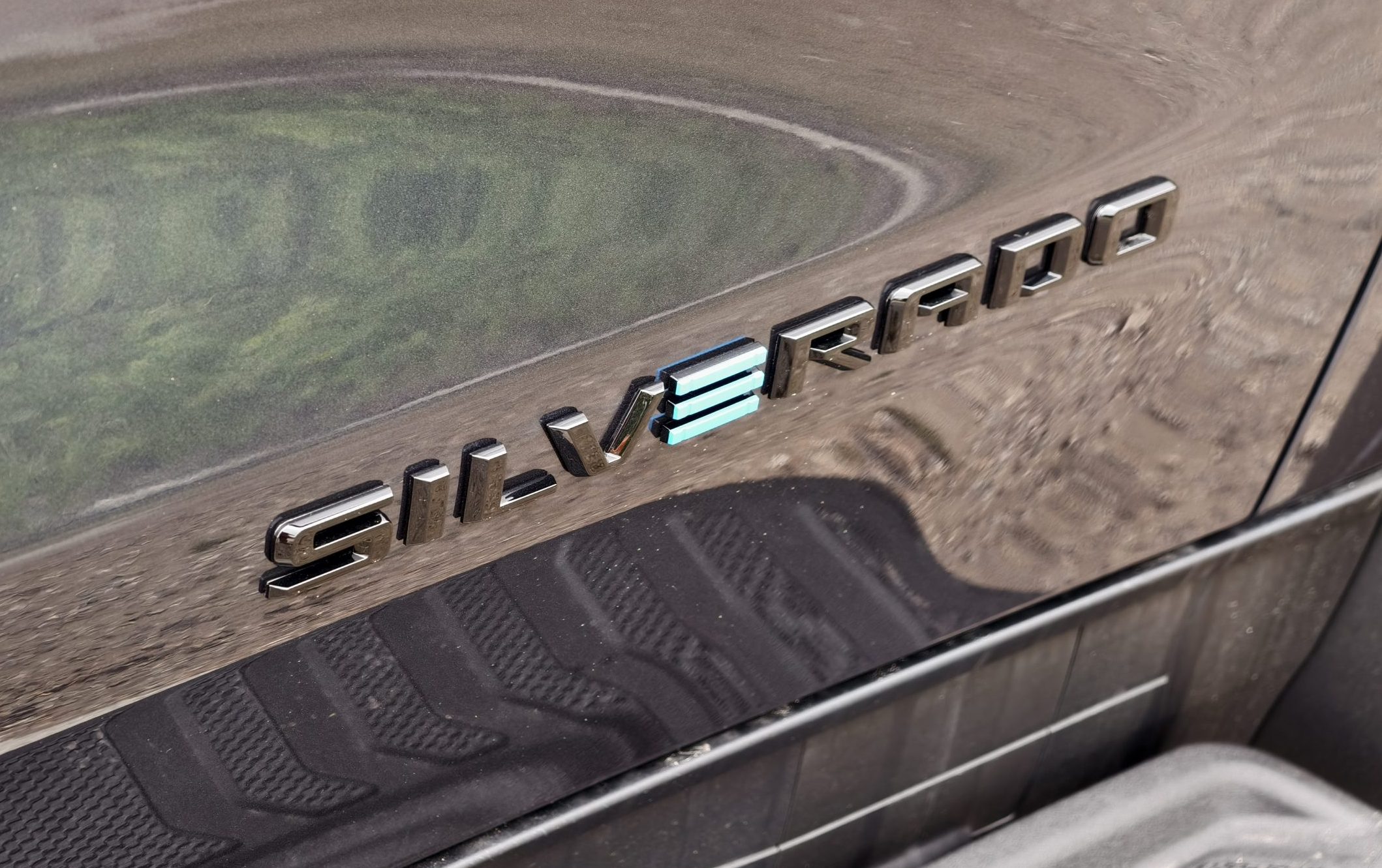
The Silverado EV was announced during the 2022 Consumer Electronics Show, and what General Motors built out of the other end is something different. The Silverado EV is not just the Silverado with electric power. Instead, GM placed the Silverado on its Ultium BEV platform, utilizing a unibody with an integrated bed and integrated frame rails. General Motors says that the Silverado EV has a similar wheelbase and dimensions to a gas-powered Silverado, but they are technically unrelated.
The secret sauce to the Silverado EV’s towing range actually isn’t all that special. In building its electric trucks, General Motors just layers on a silly amount of batteries. Unfortunately, that’s just the reality with today’s battery technology. If you want to tow a huge trailer really far, you need to get the aero as good as you can get, and then pile on the batteries. In GM’s case, the Silverado EV technically has an 800V architecture, but how this works is that GM has a dual-layer 400V battery, and the 800V and 350 kW are split between the layers.
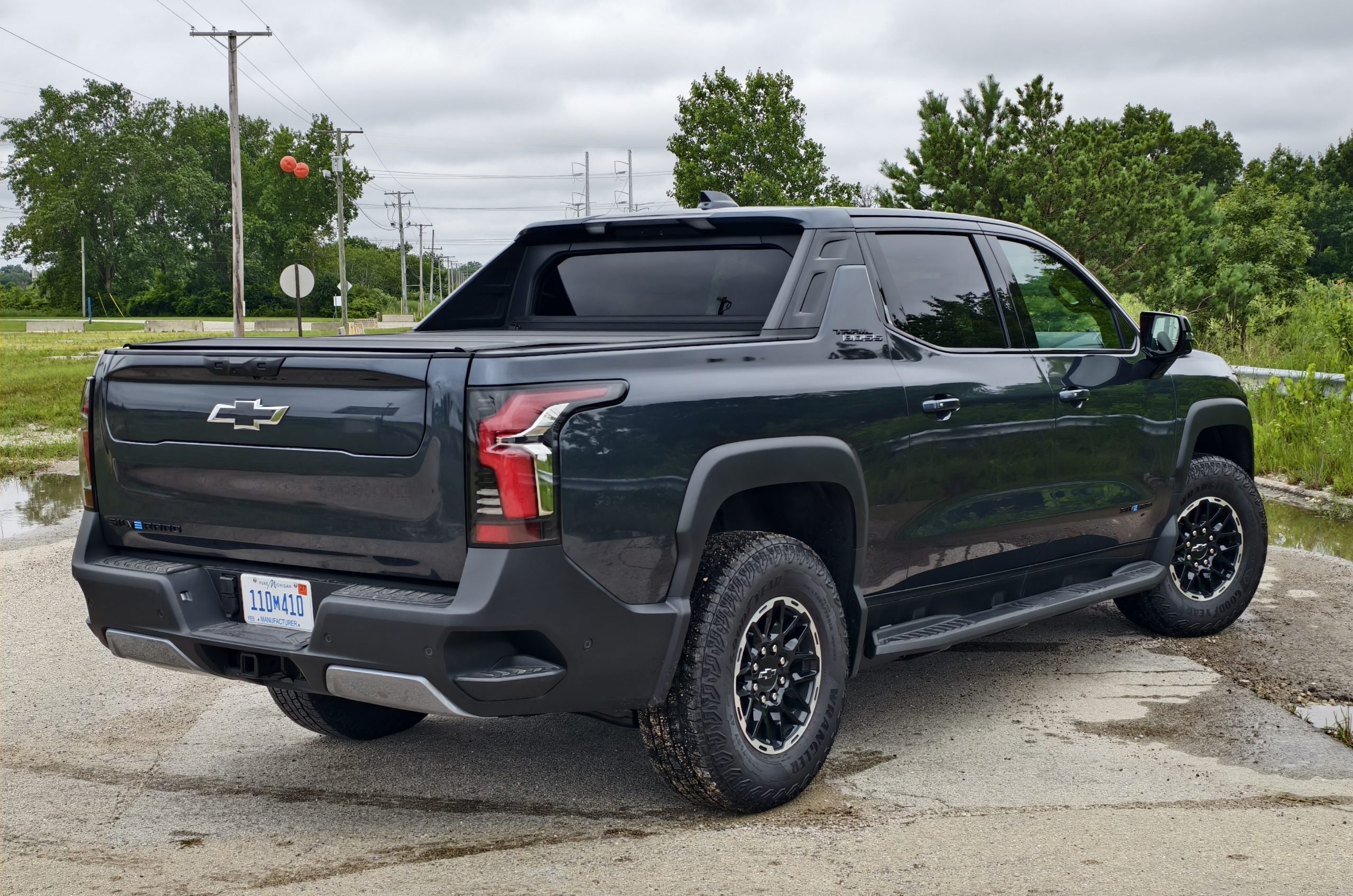
The downside of this is that GM’s electric trucks are crazy heavy. The Silverado EV 4WT weighs 8,568 pounds, while the Silverado RST is a staggering 8,953 pounds. The Trail Boss lands at a bit over 8,500 pounds. For those of you keeping count, this makes the electric about twice as heavy as an ICE half-ton truck. The Silverado is even about 2,000 pounds heavier than a Tesla Cybertruck.
A Silverado EV’s Max Range battery pack weighs 2,900 pounds all on its own. Of course, all of these batteries mean that electric trucks get expensive. Autopian contributor Sam Abuelsamid has noted that, with current technologies, batteries cost about $100 to $150 per kWh, and GM’s trucks have more than a ton of batteries, literally. I’ll get back to the cost later.
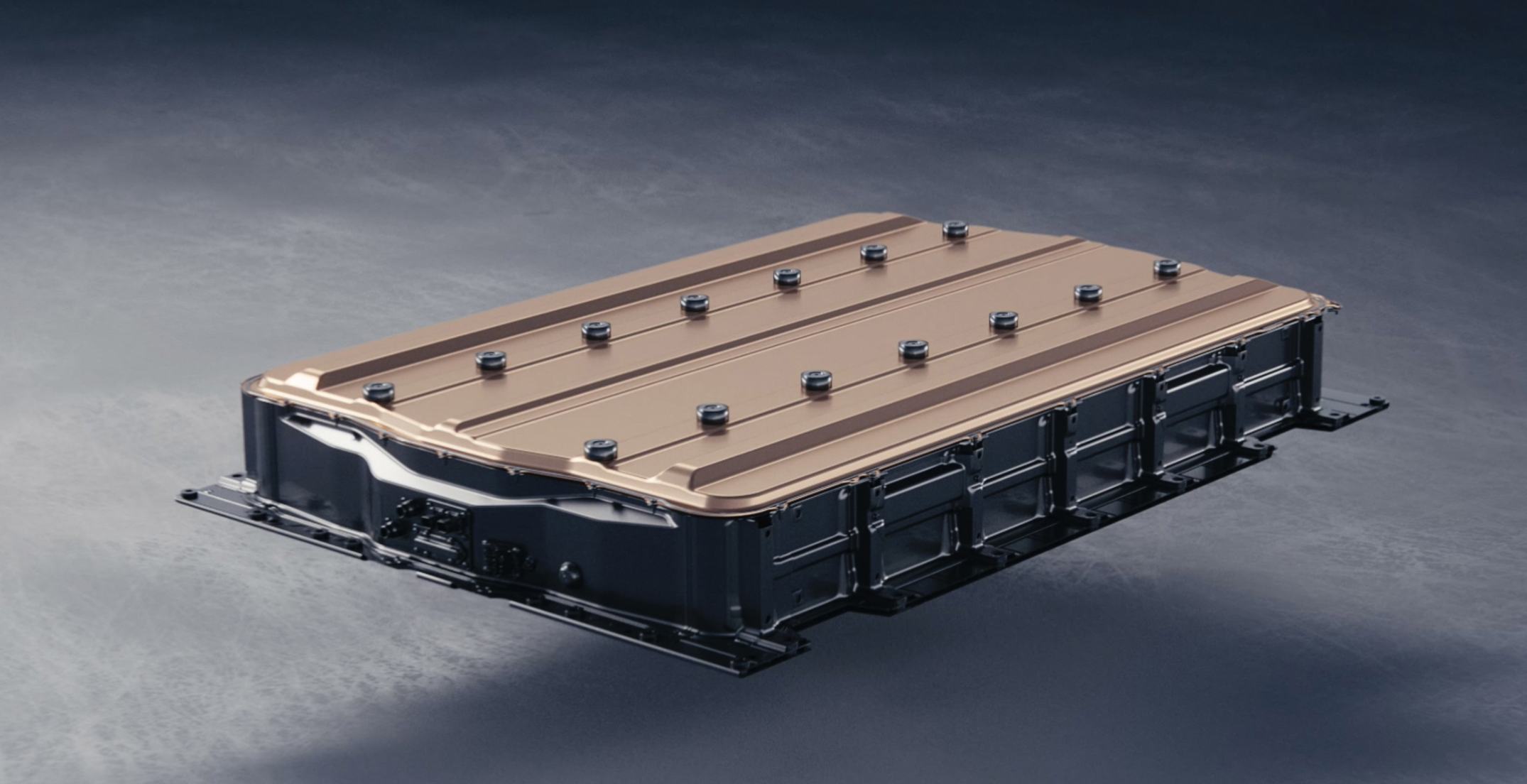
Building EVs can put a manufacturer into a vicious cycle. One of the best ways to gain range is through putting in more batteries, but more batteries mean more weight, more cost, and worse performance. Having a titanic brick of a truck that’s filled with heavy batteries is also terrible for efficiency. As a result, the Silverado EV might have the best range of its competition, but it also has pretty awful efficiency of 2.0 mi/kWh when unloaded and sometimes well under 1 mi/kWh when towing.
However, at least for General Motors, making its electric trucks hilariously heavy and filled with batteries is necessary because, at least in GM’s eyes, electric trucks need to be able to tow a trailer a decent distance. So here we are.
The big question is, what does all of the above mean in the real world?
Like A Rebirth Of The Avalanche

GM loaned me a 2026 Silverado EV Trail Boss with the 205 kWh Max Range battery for a claimed range of 478 miles and manufacturer-rated efficiency of 2.0 miles per kWh. Power comes from dual motors punching out a total of 725 HP and a whopping 775 lb-ft of torque. All of this is good for a 60 mph acceleration time just a tick over four seconds, which is nutty for something weighing as much as a condo.
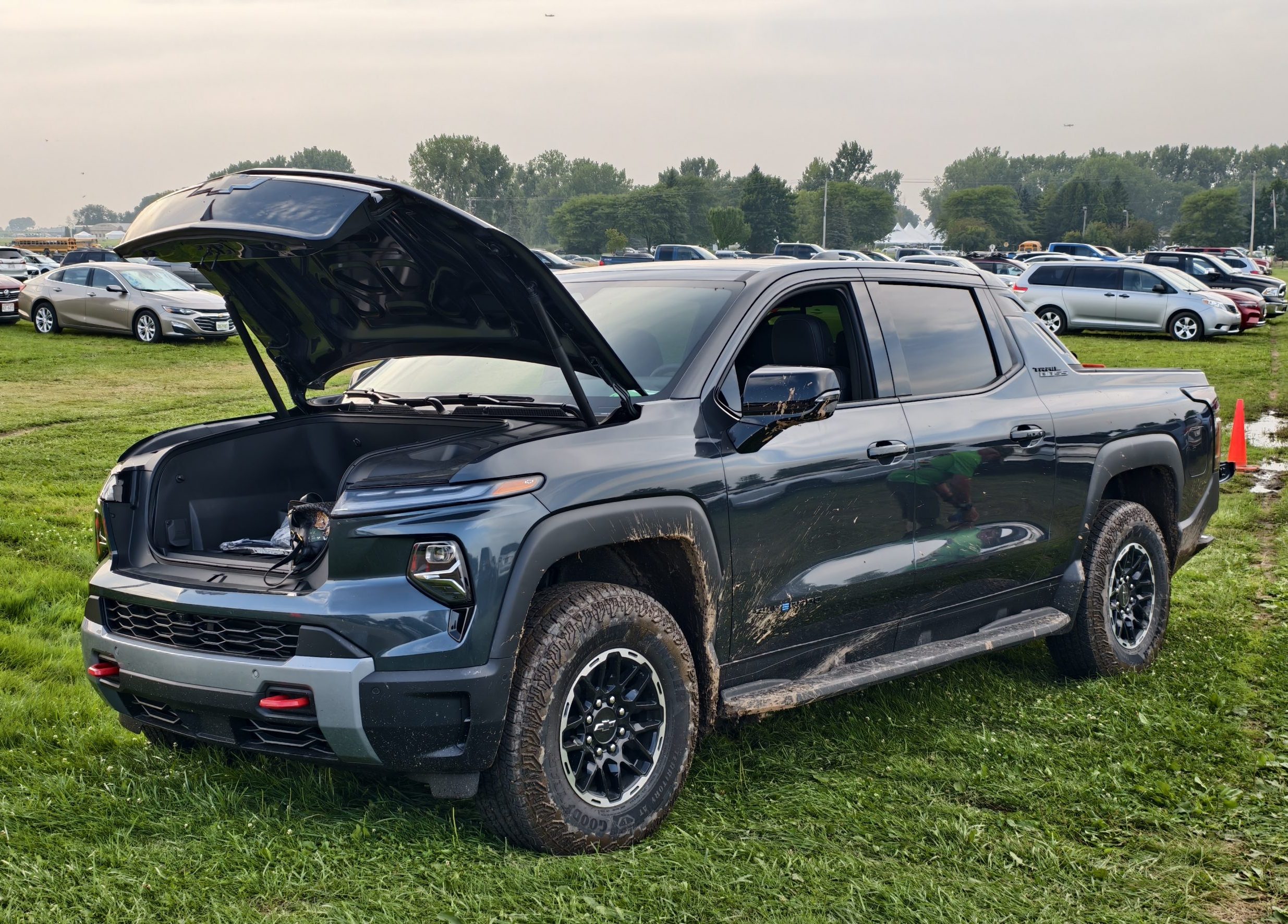
I first got to experience the Silverado EV how most people will, and that’s by driving it around unloaded. Visually, the Silverado EV looks like a futuristic Chevy Avalanche, but with more streamlining and without the huge grille that the trucks of today have. The Avalanche part is most apparent in the integrated bed, the sail pillars above the bed, and, of course, the Silverado EV’s handy midgate, which I will get back to in a moment.One neat note about the truck’s design is that, due to not needing to house a V8 engine, the hood isn’t as massive as it would be on a gas truck. Likewise, the area under the hood serves as a frunk that’s large enough to swallow a whole suitcase. The frunk can also function as a cool bench to sit on while tailgating. See?

It all adds up to the Silverado EV being an inoffensive truck that’s easily ignored in the sea of vehicles on the road. The only people who stared at the Silverado were existing EV owners. Everyone else just went about their day. If you’re the kind of person who doesn’t want to talk breathlessly about your car every time you stop, the Silverado EV will be great at helping you blend in – assuming there aren’t any EV aficionados waiting to jump out of the bushes.


Hopping into the truck further reminds you that this is no regular half-ton truck. The interior features a pair of giant screens, and the design feels more like the minimalist futurism that EV interiors are known for rather than the sort of muscular and blocky interiors that ICE pickup trucks go for. Trucks like the Tundra have giant knobs with fake exposed fasteners on them, while the interior of a Ford tries to remind you that you’re in a hard-wearing working vehicle. The Silverado EV’s interior feels like one that could have come out of any generic crossover.

The quality of this interior is not exactly as I expected for a truck that’s nearly $100,000. The dashboard was covered in a synthetic textured material that looked pretty cool and felt pretty okay to the touch, but seemed out of place in this price bracket. This was the kind of material that I’d expect to see in a $30,000 crossover.
The Trail Boss makes up for it with cushy leather seats with heating and ventilation. I also enjoyed how the truck had physical buttons for common HVAC functions; however, I do feel that the button placement was inefficient. Do we really need two separate buttons for fan speed? You could have one toggle switch for fan speed and then use the other button to toggle between blend modes.
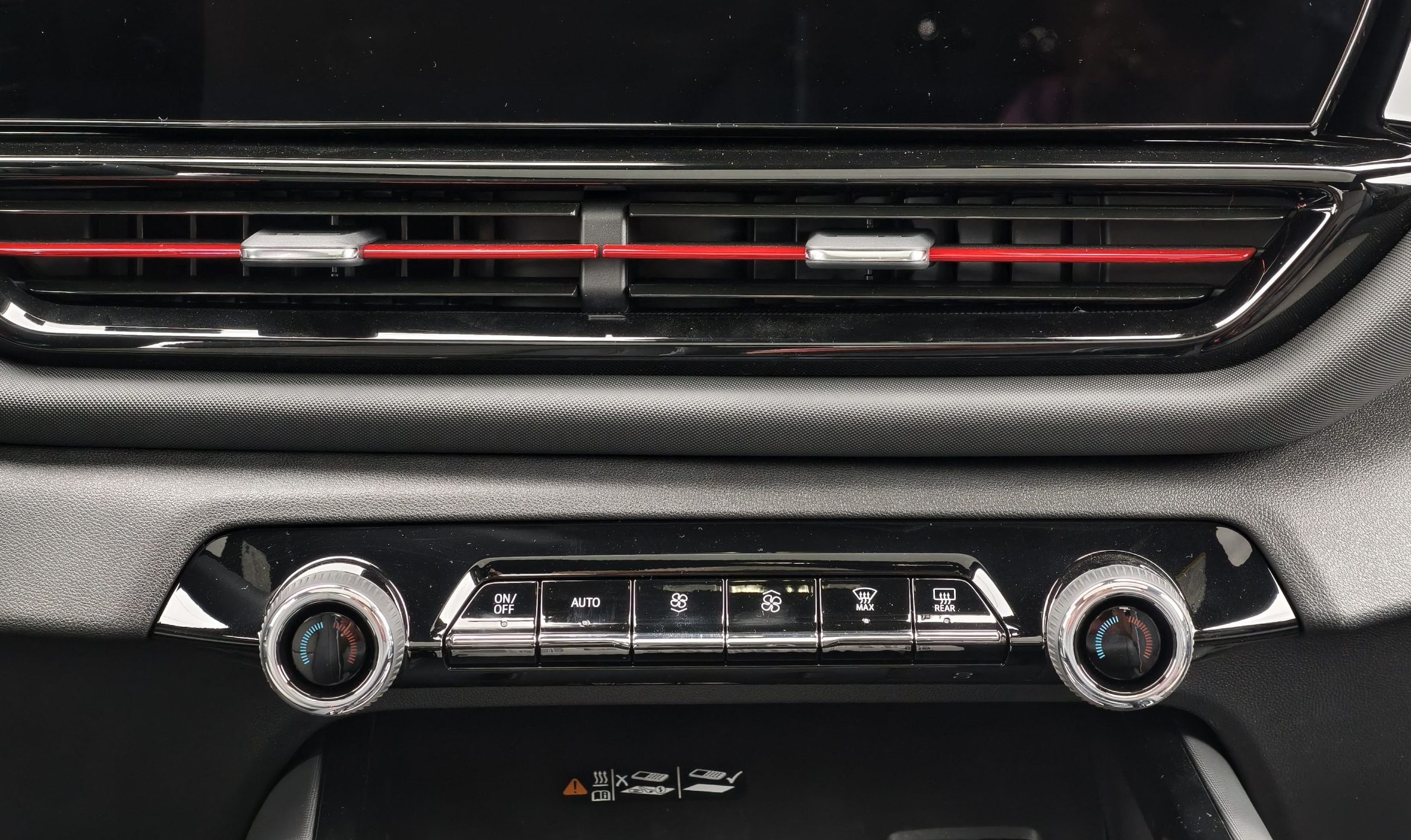
Ergonomics in the truck were pretty good, and I found that, like you’d get in a typical ICE truck, there was more than enough headroom to wear a cowboy hat while driving. My wife said that the Silverado EV had her favorite truck interior yet, and part of that was due to the fact that it didn’t really have a typical truck interior. It felt more like a car in there than a truck.
Around Town
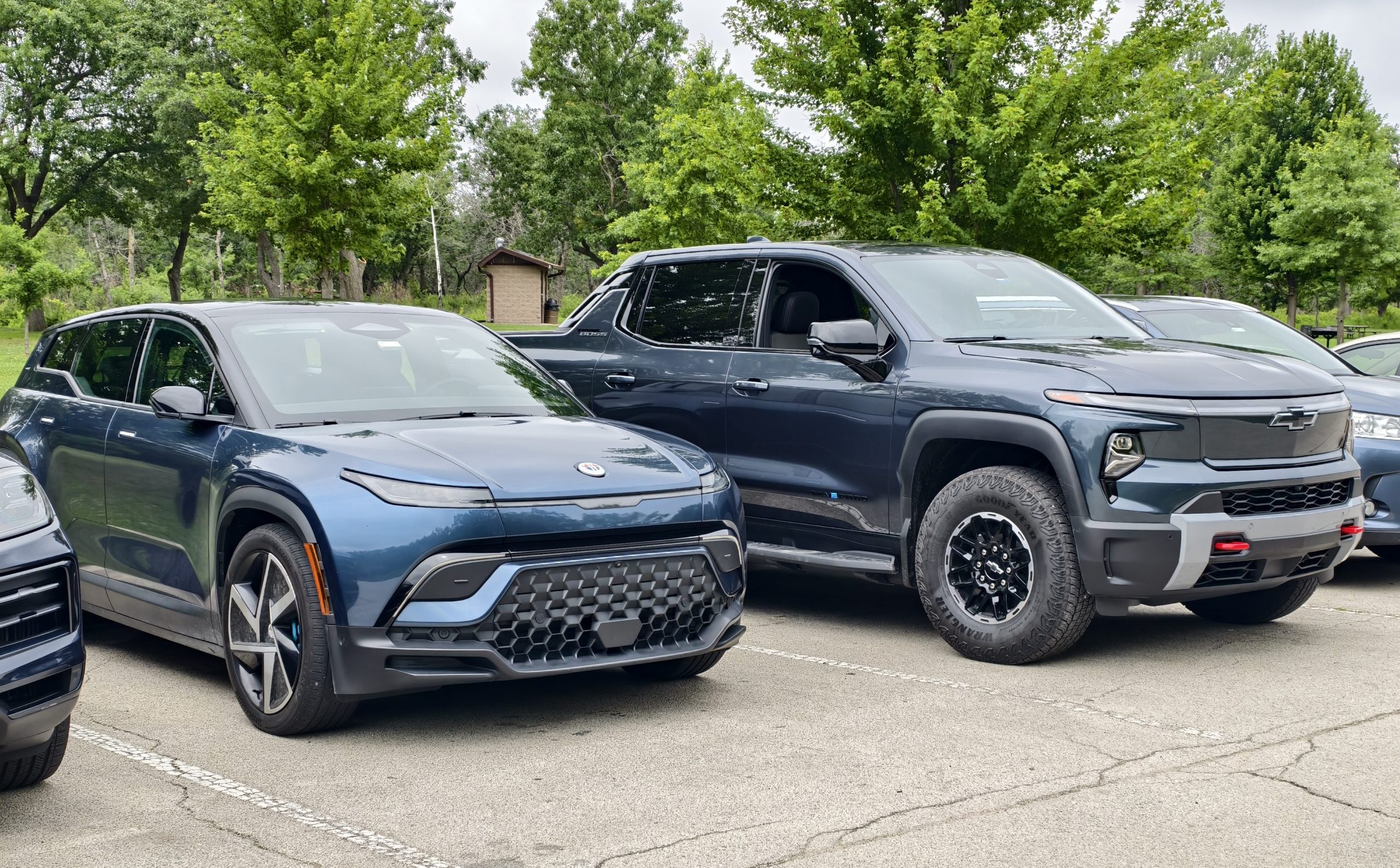
The driving experience of the Silverado EV Trail Boss was a bit unlike any other truck I had driven, and not just because it’s electric.
The electric part of the driving experience was nothing particularly special. Like all EVs, the Silverado EV leaps off the line with a stupid amount of power, and it accelerates way faster than you’d expect 9,000 pounds of truck to go. The Silverado EV is so fast that it can outrun legitimate sports cars in a straight line. The Silverado EV also makes driving fast so easy that it can be dangerous for pedestrians and other drivers if you aren’t careful. But again, none of this is particularly surprising as pretty much all EVs are crazy quick nowadays.

I also wasn’t at all surprised to find that this huge heap of truck didn’t have particularly great handling. Throw the truck into a corner, and the body will want to continue in the direction you just departed from before being forced to turn by the tires, which then scream in pain because you fancy yourself as a racing driver while commanding something weighing as much as a small cruise ship. Though quick in a straight line, the Silverado understandably does not like to be hustled through turns. Otherwise, handling is safe and predictable, and the truck’s suite of stability control and traction control aids will try to keep you from having too much fun. Don’t expect to take your Silverado EV on any track days.
The Trail Boss features an independent coil suspension with a factory lift and a hydraulic rebound control system. In addition to the high-riding suspension, the Trail Boss has 18-inch wheels, 35-inch all-terrain tires, meaty tow hooks, and a special off-roading mode. This is compared to the air suspension that you get in the regular Silverado EV. The Silverado EV weighs as much as a heavy-duty pickup truck, but it has the ride of something like a half-ton Ram. The suspension soaks up bumps well enough that you should feel pretty comfortable, even on long trips.


The Trail Boss made for an excellent daily driver. It’s supremely quiet, even with the faint rumble of all-terrain tires in the background. The truck has a plethora of cameras to help you fit into tight spaces, rear-wheel-steering that genuinely makes the truck feel a little bit smaller when you’re maneuvering, and the Android Automotive operating system in the infotainment screen didn’t take very long to get used to.
Quirks
Sadly, I do have one major complaint about this interior, and it’s about quality. One of the speaker grilles wasn’t fully installed. This truck had just 300 miles on it when I got it, and somehow, nobody noticed this? Some heavy percussive maintenance with my fist locked the speaker grille in place, and it did not come back up again for the rest of the trip.
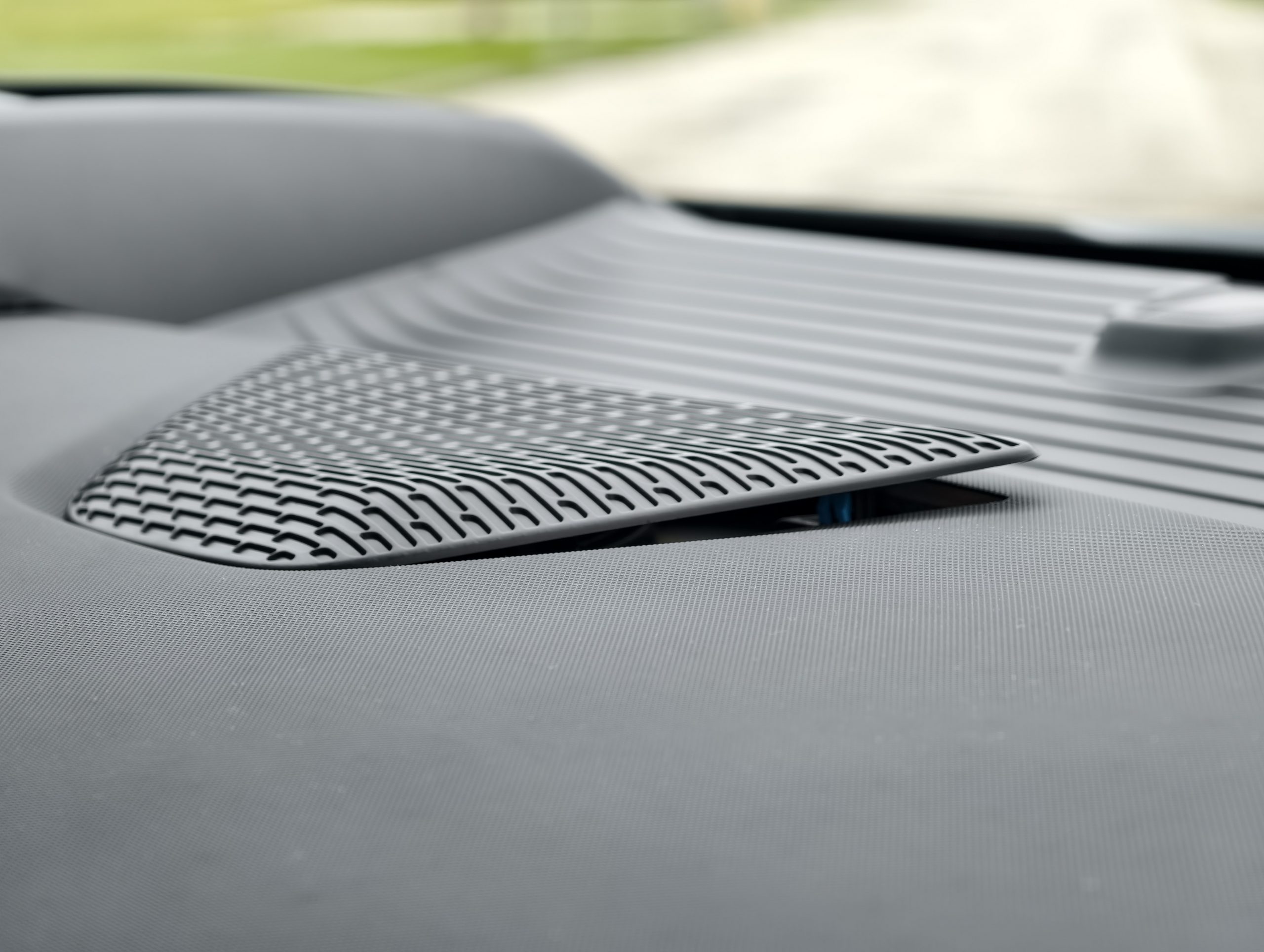
One of the trim panels attached to the steering wheel was also not fully installed. This one had no fix. Every time I snapped it into place, it popped right back out again.
This truck also had dashboard stitching to match the seats. It was a nice visual touch, but the stitches were more or less fake since they weren’t joining any seams together, and some segments of stitching weren’t straight. This was the same observation Sam made in his Silverado EV tester back in 2024.
The stereo in my truck was a Bose 7-speaker unit, and it was fine. It wasn’t nearly as crisp or as rich as Ford’s Bang & Olufsen system or the Harman Kardon systems in Ram trucks, but the Bose system did deliver healthy bass and remained clear even at the high volume levels that I play my music at. You aren’t likely to impress anyone with this system, and you don’t really get a surround-sound feel, but you can have a more than satisfying sonic experience in this truck. Mercedes Jam Session Approved!
About The Midgate
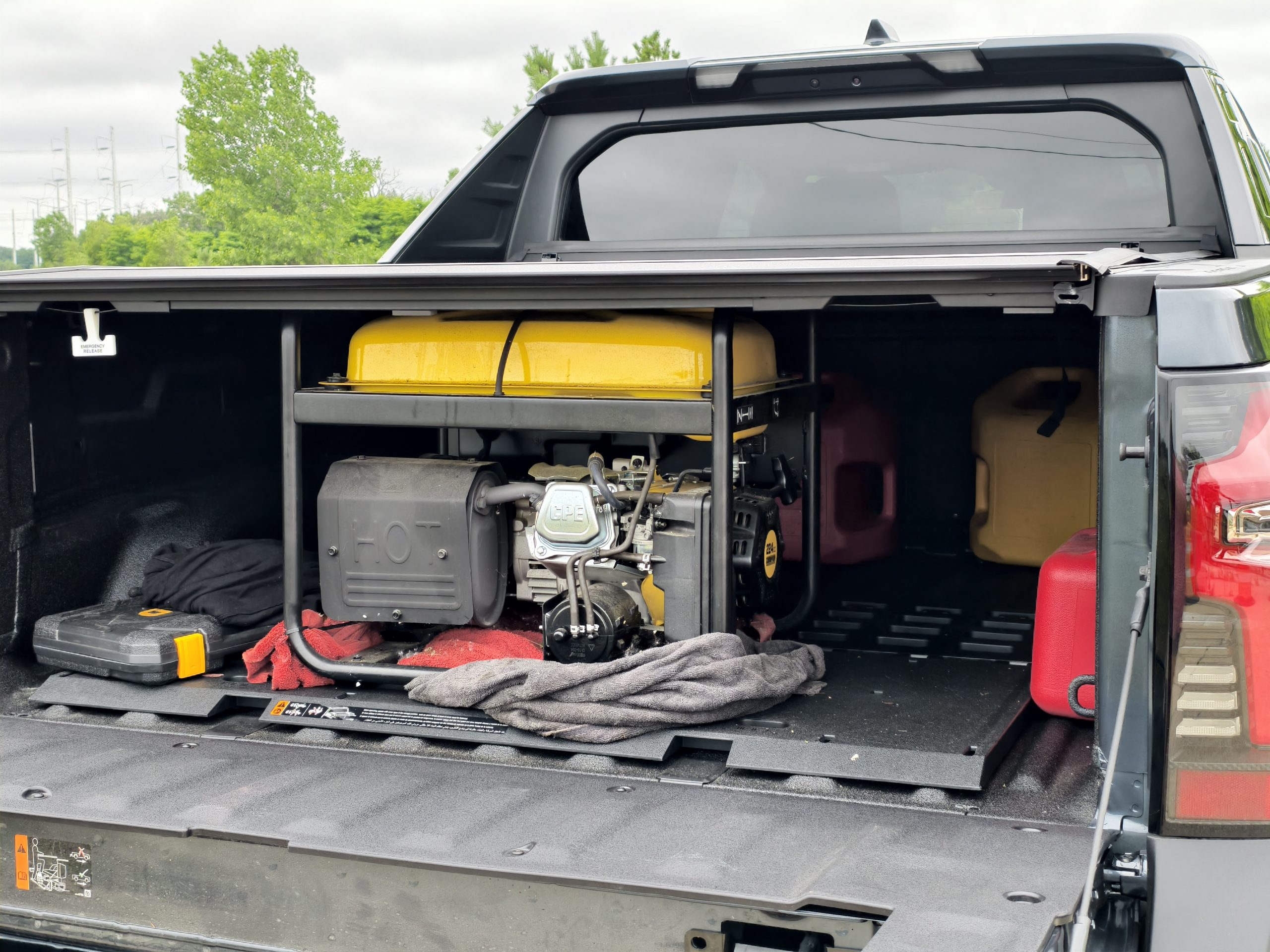
The midgate also brought an interesting quirk. I carried four gas cans along for this trip to fuel my generator. When I carry gas cans, I always secure the cans to a tie-down in the bed so they aren’t just sliding around. This works flawlessly almost every time. In the past, if a gas can went rogue and broke loose, it was no big deal – mop up the gas spill, wash the bed, and keep on truckin’.
On one gas station visit, my dad helped me fill the cans, but he skipped the tie-down step. Later, as I was driving the Silverado EV around Oshkosh, I started smelling gas. Wait, I’m in an EV, why does it smell like gas? As you have probably guessed, one of the gas cans had turned over and was leaking fuel, the fumes of which leaked through the midgate’s seals. The tonneau cover was open, unlike in the photo above, but that didn’t matter. I cleaned up the spilled gas, washed the truck bed, and washed the midgate, but the smell of gas lingered inside the truck for about a day.
During the drive home, I had the generator in the bed and under the now-closed tonneau cover. I had drained the gas out of it, and the gas cans were now in a different truck, so I figured that wasn’t going to be a big deal. Yet, the interior of the Silverado began smelling like a hardware store, or basically what my generator smells like.
I don’t know if my truck had an issue or if that’s just how the midgate is, but definitely be careful. If you’re carrying a load that emits a foul odor or has fumes, keep the tonneau cover open and try to prevent spills.
The Big Haul
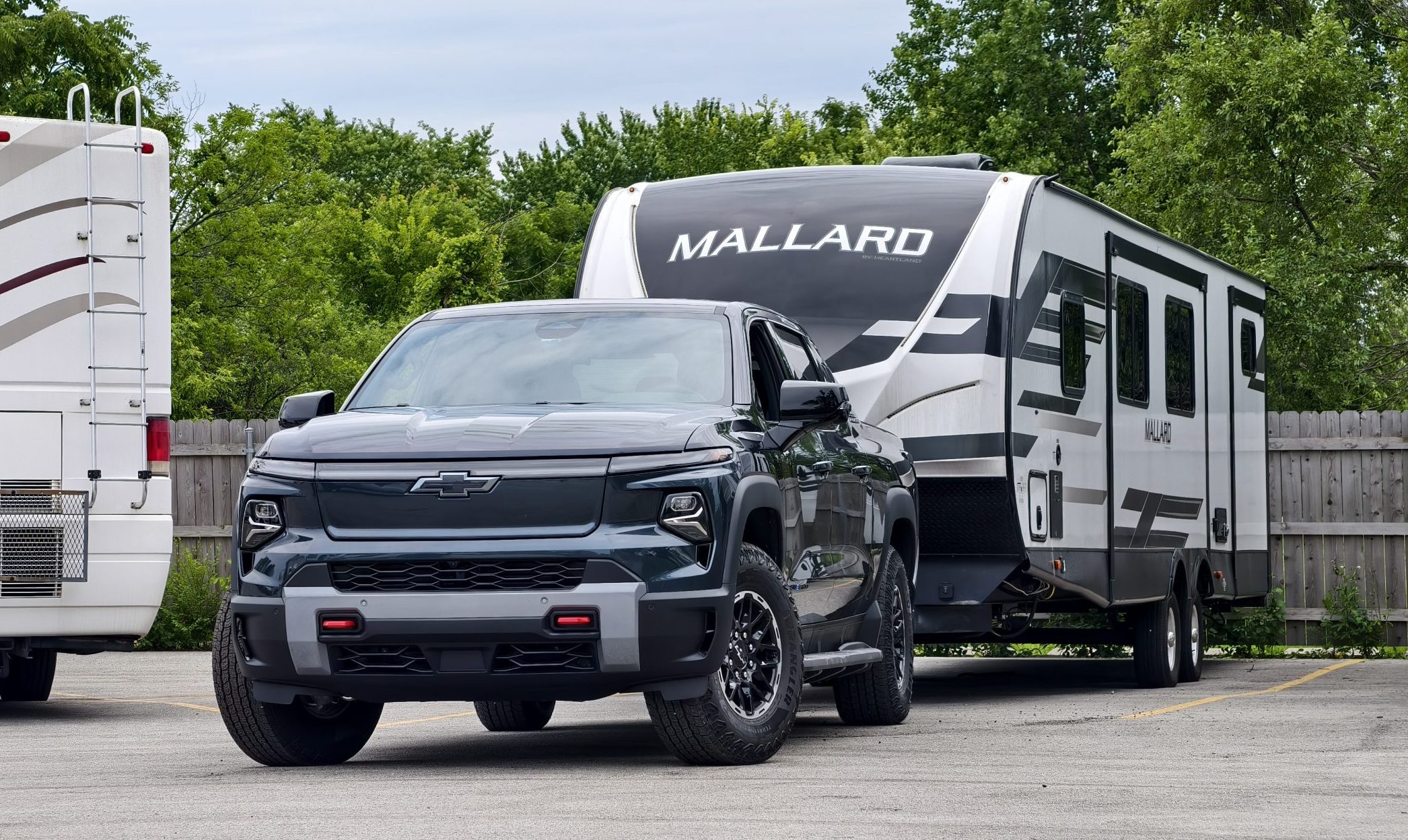
The Silveradio EV is made to haul, not for puttering around town. What we’re really here for is towing, and I did plenty of that. I started off my trip to Oshkosh by topping off the truck’s battery. I had taken the truck to the beach and around town, consuming about 25 percent of the battery to drive 100 miles. Keep in mind that I was having lots of fun with the truck’s Wide Open Watts (WOW) Mode, which unlocks the truck’s maximum acceleration potential. I went to a local Thornton’s gas station, which had a 150 kW charger that topped me up to 100 percent in about 40 minutes or so while I wrenched on my generator’s carburetor.
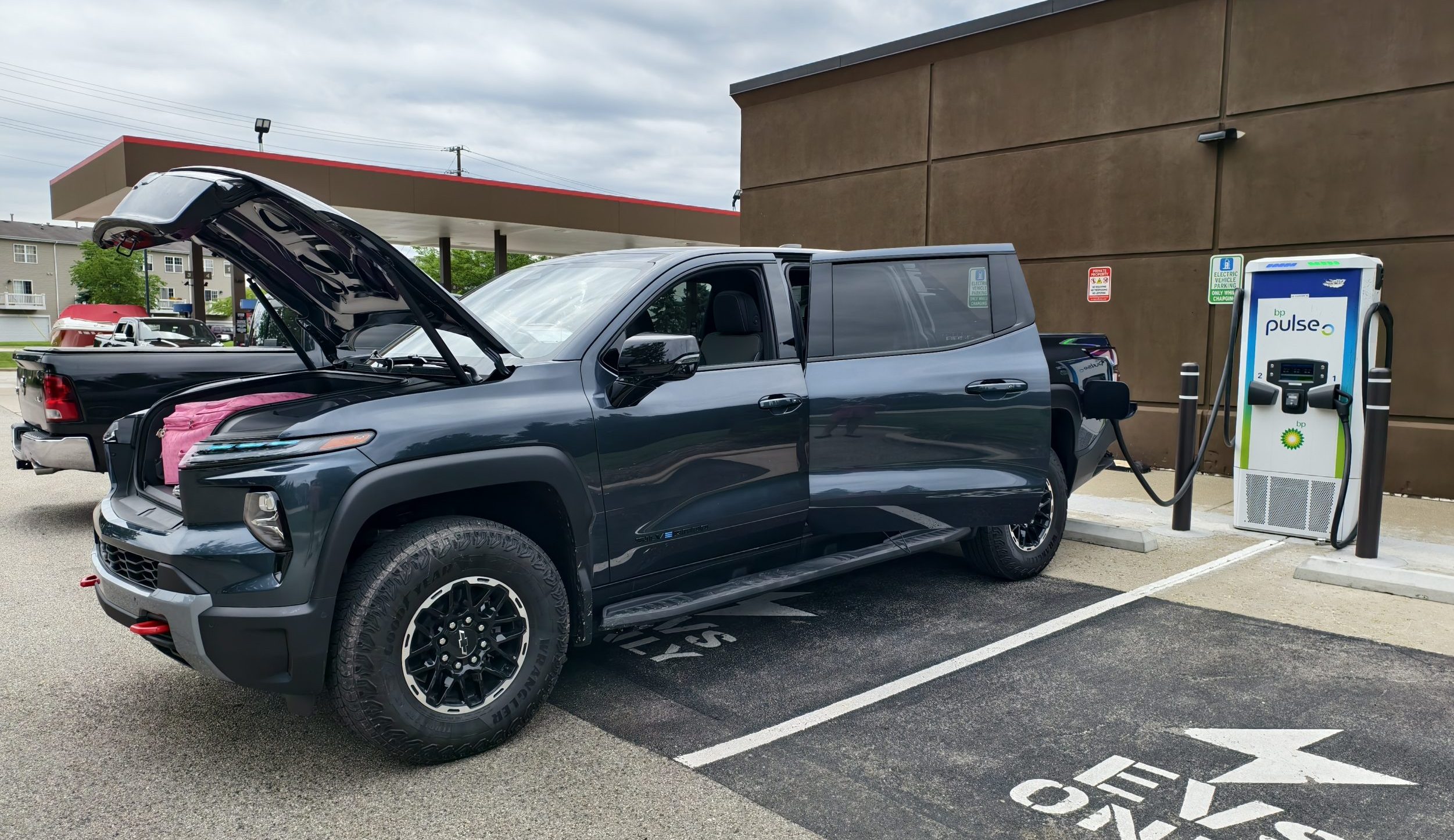
With a totally full battery, I drove over to my parents’ place to pick them up, and then I drove to where they had their trailer stored. The total distance here was about 20 miles, and I averaged about 2.4 mi/kWh, arriving at the storage facility with 95 percent battery.
Hitching up the trailer went no differently than the hitching process with a gasoline truck, and then it was time to hit the road. Earlier, I mentioned the 2022 Heartland Mallard M33 has a dry weight of 7,746 pounds and measures 36 feet, 9 inches long. However, quoted dry weights are never truly accurate, especially after you factor in options, propane, and water. In my case, the actual weight was likely closer to 8,000 pounds.

This is important because while the Silverado EV has a max towing capacity of 12,500 pounds and a max payload of 1,800 pounds, that figure is only for the low-end work truck models. The Trail Boss, like other higher models, has a towing capacity of 10,000 pounds and a payload of 1,500 pounds. In other words, the family camper used up about 80 percent of the truck’s capacity.
Yet, the truck didn’t seem to care. The Silverado EV is so powerful that it accelerates fast even when towing a heavy trailer. It pulls from a dead stop so fast that, if you have a poorly built camper, you can probably cause damage to it just by yanking it so hard with the Silverado EV. This truck accelerates as hard, if not harder, than a diesel truck, but without shifting, diesel exhaust fluid, particulate filters, diesel fuel, or anything like that.
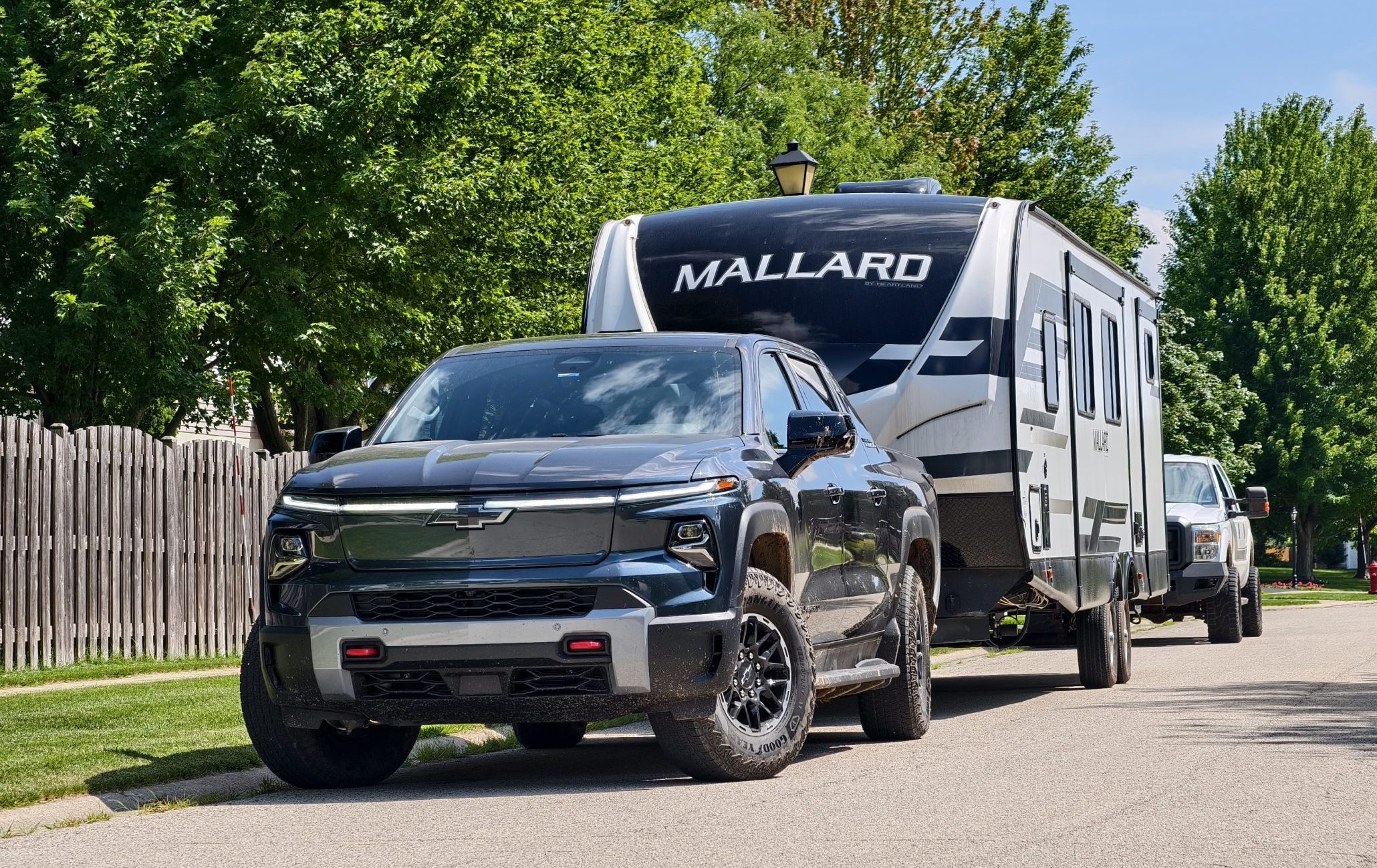
Once you hit cruising speed, the diesel-like performance continues, as the Silverado has a groundswell of power in store for passing and climbing hills. Add in great stability, the quiet interior, and GM Super Cruise, and the truck makes towing a huge trailer feel basically effortless. Just point the truck down the road, and it’ll pull you and the trailer along for the ride without breaking a sweat.
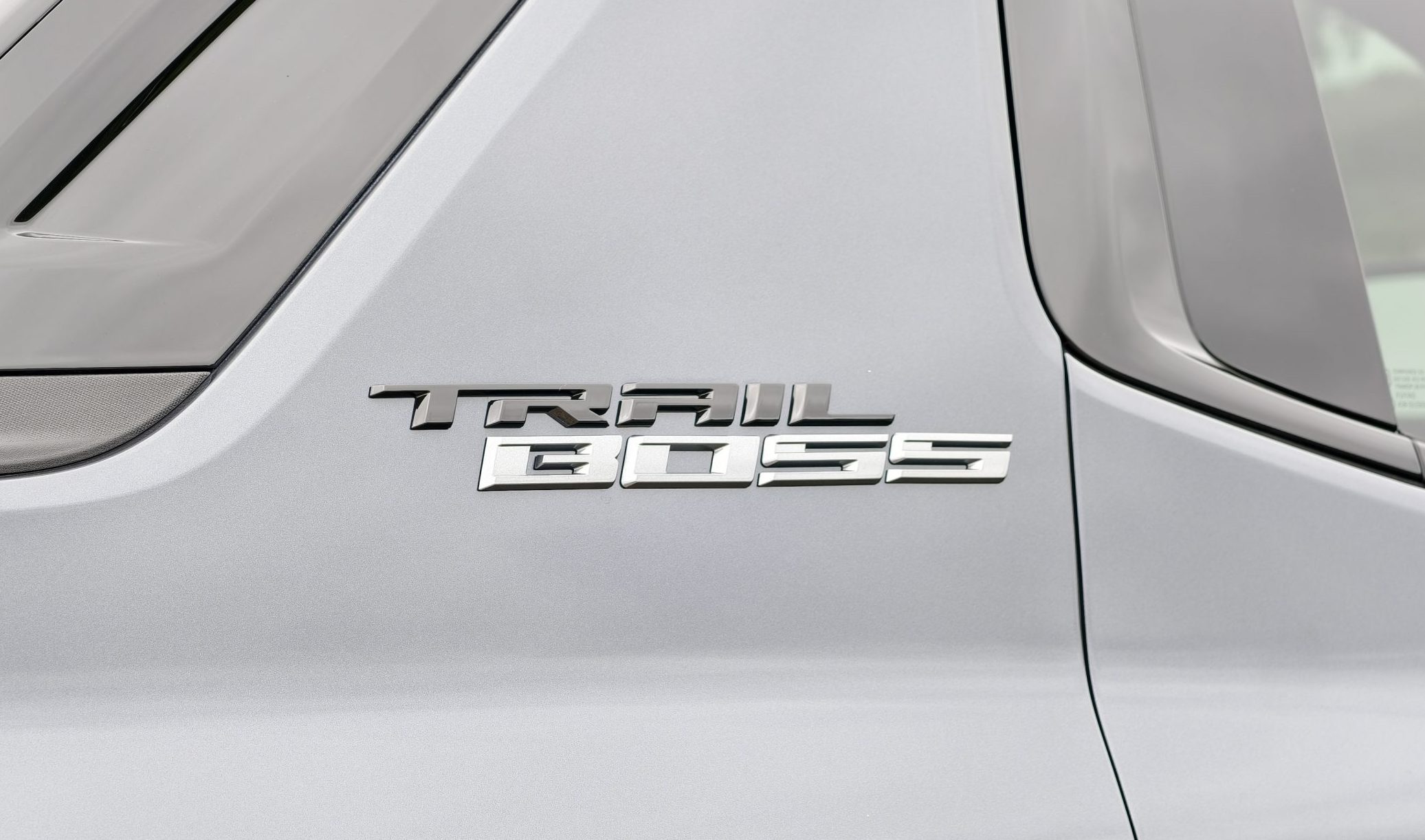
I even love how the truck uses a combination of regeneration and friction brakes to pull the whole rig to a stop in a manner that feels more confident than an ICE truck. I can’t believe I’m saying this, but I’d rather tow a big trailer with an EV than with a diesel truck. Look, I know, I’m the Autopian’s resident diesel freak. But it’s hard to deny just how great the Silverado EV is a handling trailers.
But here’s where my compliments turn to concern.
Bizarre Problems
The first problem I had was with Super Cruise. The system worked great about 95 percent of the time. It was alarming how freakishly good the robot was at towing a trailer. We stayed perfectly between the lines, kept a consistent pace, and the truck was a safe driver, keeping a good distance away from traffic in case of an emergency. The only feature that didn’t work while towing was Super Cruise’s automatic lane change function, but the truck had no problem taking back over once you helped it do a lane change.
What concerned me was the other five percent of the time. There were times when, seemingly out of nowhere, the truck would begin to accelerate by itself. I chose a cruising speed of 65 mph for much of my trip, and when the truck started accelerating by itself, I often saw it creep to 75 mph, 80 mph, or even 85 mph on the cruise control display.
On the other hand, the truck sometimes slammed on its brakes for no apparent reason. Not full panic-braking force, but definitely something akin to the hard braking you might apply when a car in front of you suddenly jumps on the binders and you find yourself too rapidly closing distance. When these braking incidences occured, there wasn’t any traffic in the truck’s way, or a construction zone, or anything like that – but the truck would brake hard, and I’d look down and see that Super Cruise set itself to 45 mph or 50 mph.

Now, it would be easy to say that maybe I flicked the speed switch without realizing it, but here’s the thing: Super Cruise is a hands-off driver assist system. I can’t adjust the speed if I’m not touching the steering wheel, which I wasn’t.
My best guess is that the truck was misreading speed limit signs. There was one occurence when I was able to watch this happen in real time. I had the speed set to 65 mph, and upon passing a 70 mph sign, the truck changed the setting to 75 mph and began accelerating. The speed limit where I was driving on I-94 and I-41 in Wisconsin never exceeds 70 mph, so the truck had no reason to be selecting speeds as high as 85 mph.
I considered dirty camera lenses as a culprit for misread signs (if mis-read signs were indeed the problem), but the truck was clean. Sadly, in my time since having the truck, I’ve gotten no closer to getting a clear answer as to what Super Cruise was doing.
The other part of that 5 percent includes a time when Super Cruise pulled a right turn at 65 mph, which would have driven the truck off of the highway had I not been paying attention, and another time when Super Cruise attempted to drive into the shoulder after a semi-truck passed us on the left. This happened enough times that my mom and I started joking about how the robot is afraid of semi-trucks.
While these events were infrequent enough that I continued to use Super Cruise, I think they’re worth mentioning because they can be critical safety issues if you don’t take over the second the truck makes the mistake.
The Charging Pickle
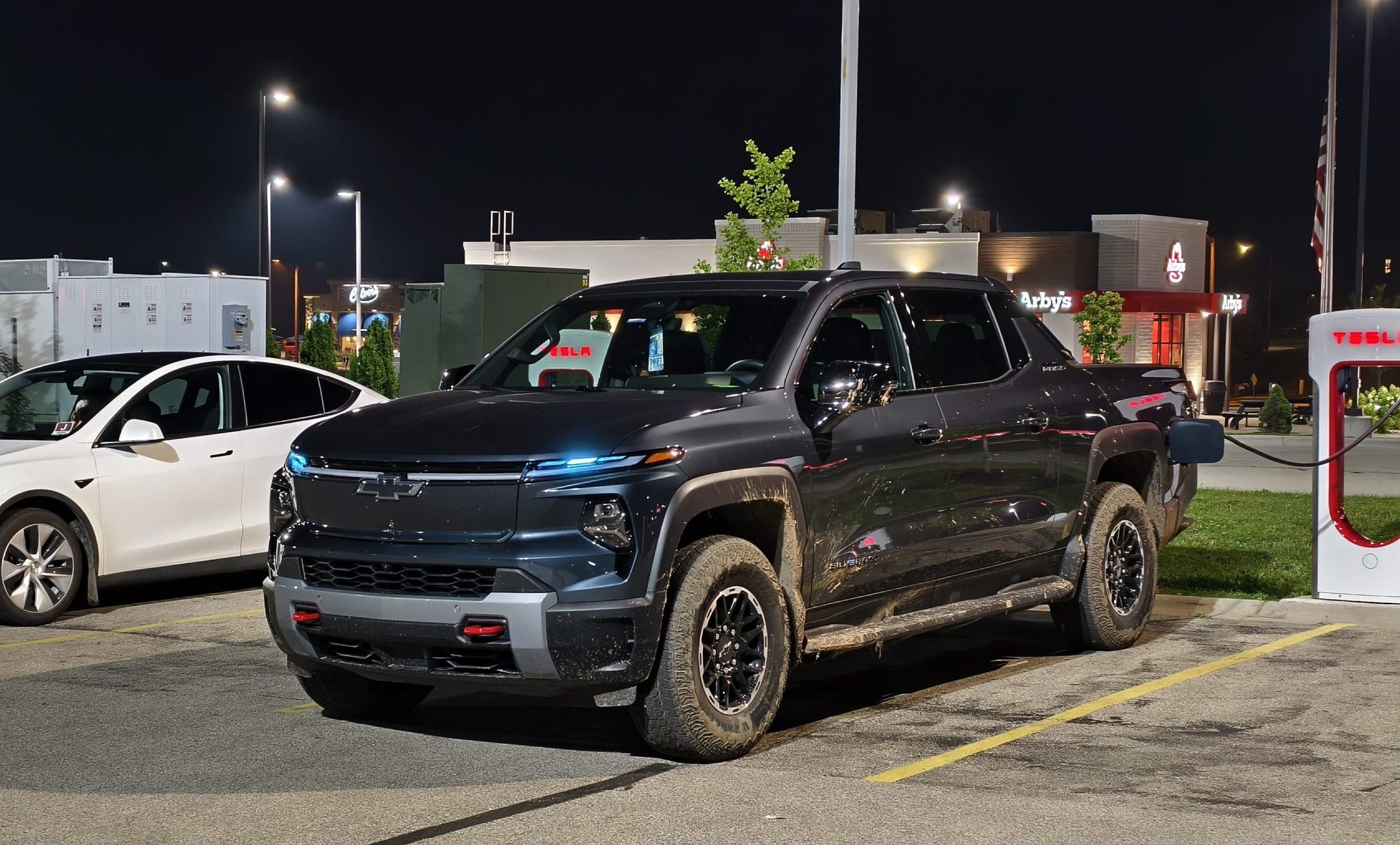
When I wasn’t babysitting Super Cruise, I also found myself in another pickle. The Silverado EV Trail Boss averaged 2.1 miles per kWh when I was driving it empty on the highway. With the trailer, I got between 0.7 mi/kWh and 0.9 mi/kWh. This truck was absolutely guzzling down its battery.
Now, because the battery had 205 kWh of usable juice, that still results in decent range. A rating of 0.9 mi/kWh results in a theoretical range of 184.5 miles, which is pretty awesome considering the circumstances. However, the times I averaged 0.7 mi/kWh concerned me because that’s a theoretical range of 143.5 miles. The drive from the camper’s storage spot to Oshkosh was 133 miles, so you can see my concern there.
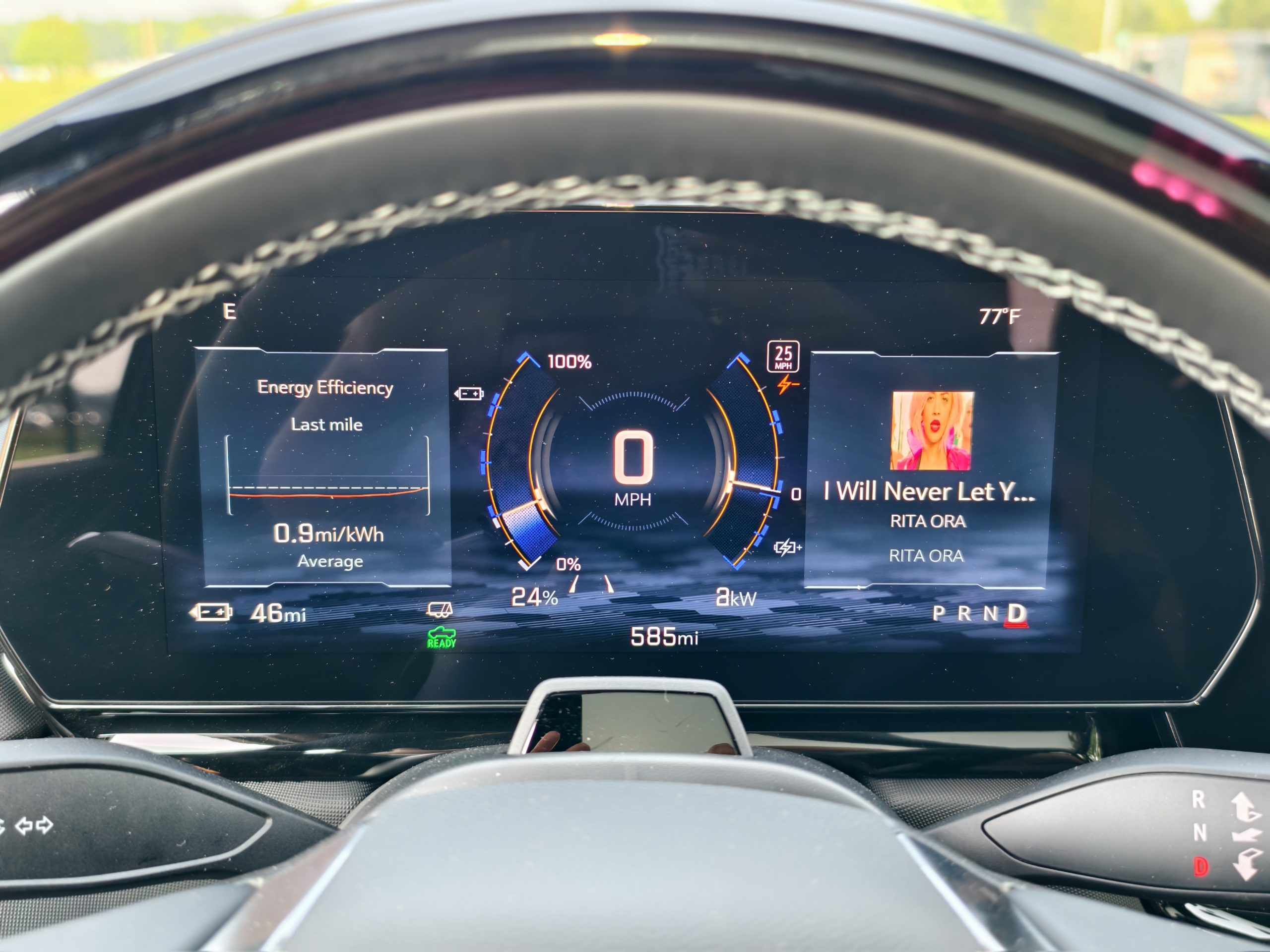
Weirdly, this wasn’t range anxiety, at least, not in the traditional sense. There were tons of fast chargers all over my route. The problem is that pull-through charger infrastructure is currently nonexistent in many parts of America. Yes, truck stop chains, General Motors, and others are working to build trailer-friendly EV chargers, but they just don’t exist yet in many regions, and one of those regions includes massive swaths of Wisconsin. There wasn’t a single pull-through charging station along my route.
If I had to stop to charge, I really had only three choices. I could either charge with the trailer hooked up, and block 40 feet of a parking lot, I could detach the trailer and the weight distribution hitch springs, charge, and then hook back up, or I could find one of those Tesla stations with a solitary stall that’s compatible with EVs towing trailers, and hope that whoever designed the lot didn’t put that charger next to the parking lot entrance.
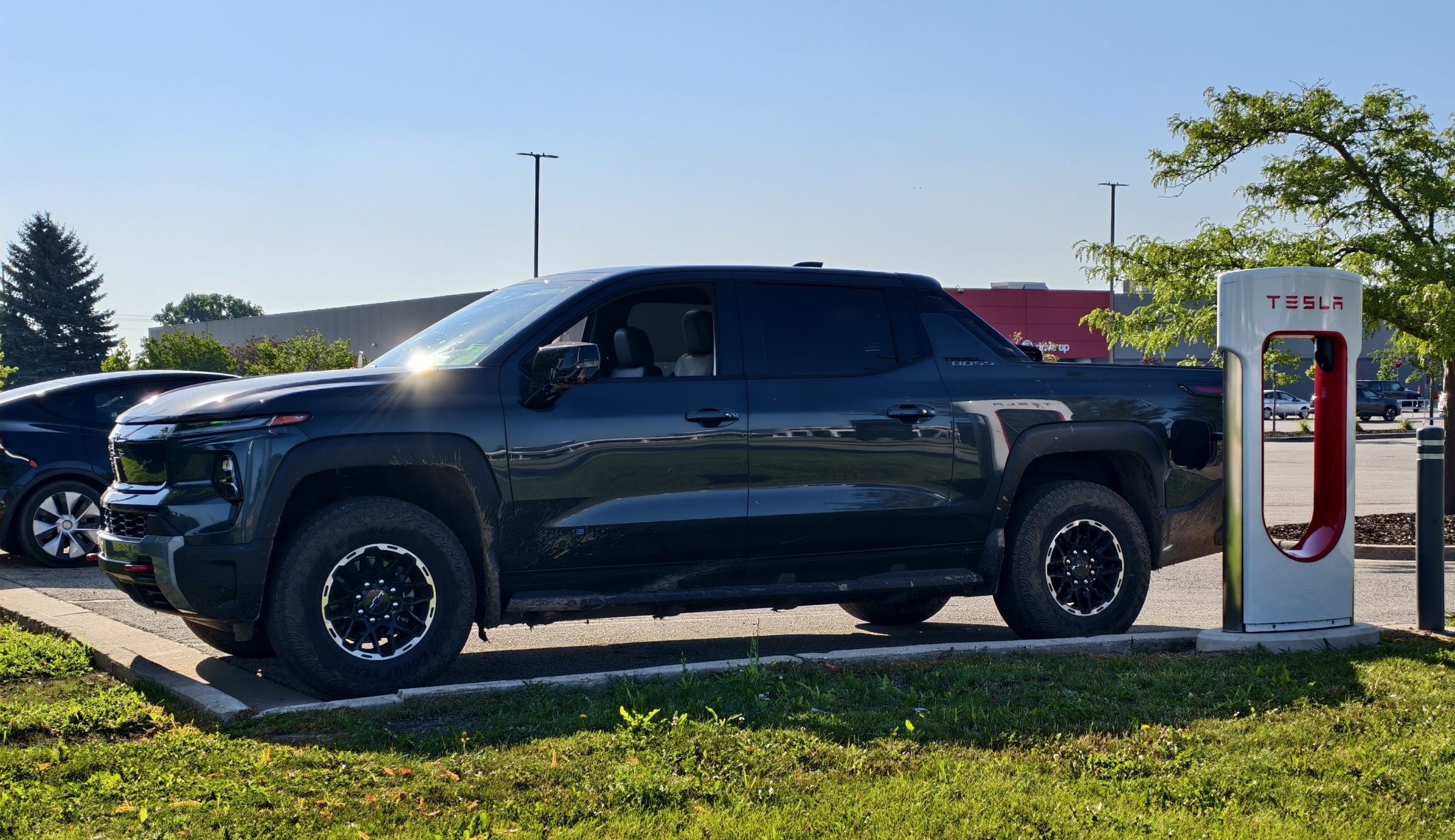
That’s it. Those were my three choices, and they all sucked. Making matters worse was that, as I discovered, there are a lot of chargers that are listed on apps like PlugShare as being fast, but when you plug in, you get a charging rate that’s barely better than Level II.
Oh, and there’s one more curveball, too, because my Silverado EV tester could not accurately estimate remaining range when it was towing. When I hitched up the trailer and turned on tow mode, the truck told me that I would reach my destination with 51 percent charge remaining. I knew that was a load of nonsense. I assumed the truck would average about 1 mile per kWh while towing, which would mean spending at least 133 kWh of the pack to drive the 133 miles that I needed to drive. Now, I’m not a mathematician, but that’s more than 51 percent.
I figured that the estimated range would correct itself as I pulled the trailer. The problem was that while the range estimation slowly counted down, saying that I’d arrive with maybe 45 percent battery or maybe 35 percent battery, the estimation was always very optimistic. If I could suggest an improvement, it would be that the range estimator should be able to pull data from the truck’s efficiency monitor. The truck knew it was averaging 0.9 mi/kWh, but the estimator apparently didn’t get the memo.
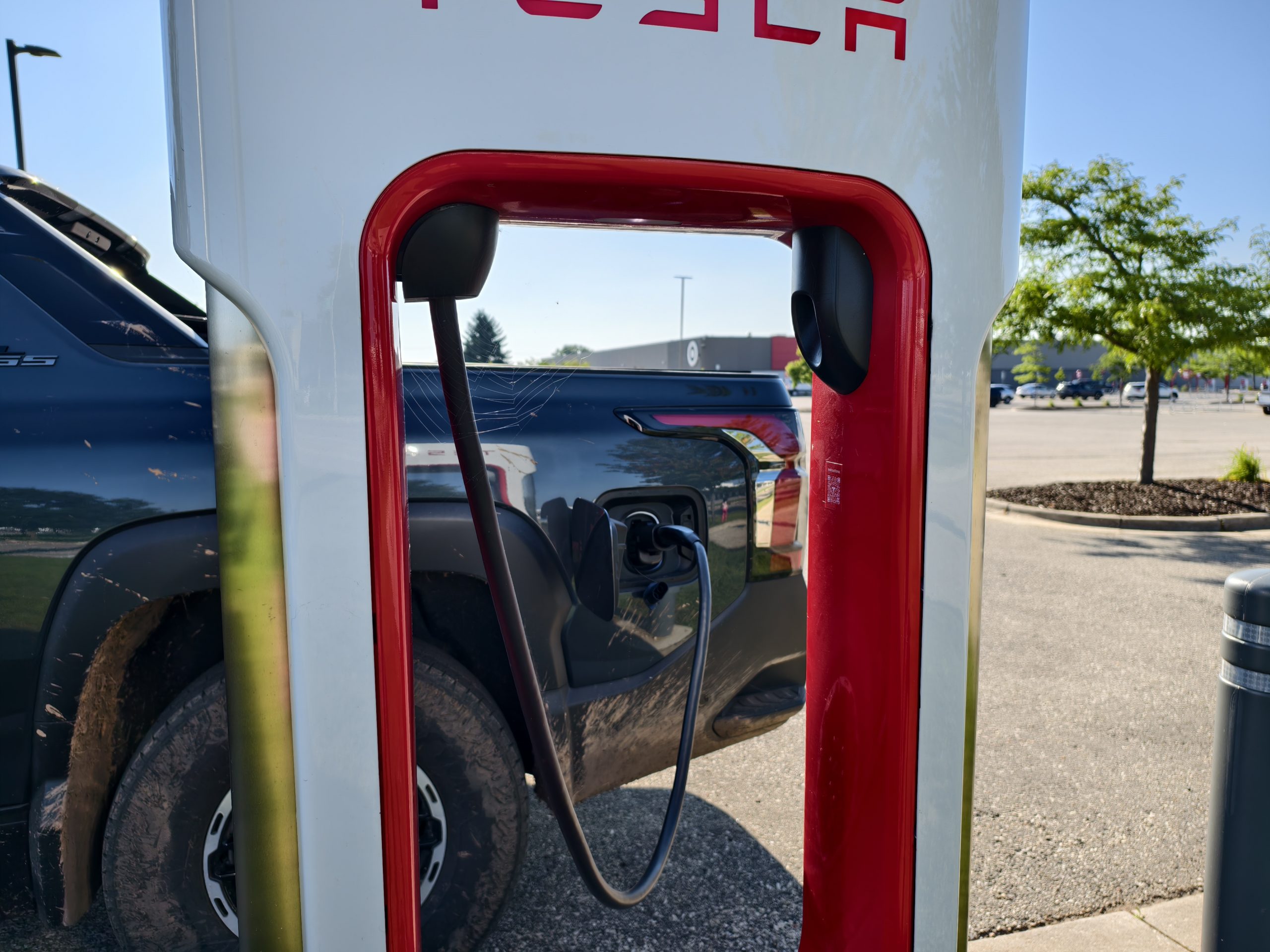
Instead, I calculated range by hand. I set the truck to a constant 65 mph, and during the trip to Oshkosh, I maintained a consistent 0.9 mi/kWh. Based on my hand calculations, I’d make it without issue so long as my efficiency didn’t drop. I ended up ignoring the range estimator for the entire trip, which was annoying, because I was basically betting on my math being correct.
Thankfully, I arrived at camp with a 24 percent remaining charge after consuming 71 percent of the battery. I then let the truck sit overnight without charging it, and by the next morning, the truck actually read 28 percent charge. Neat!
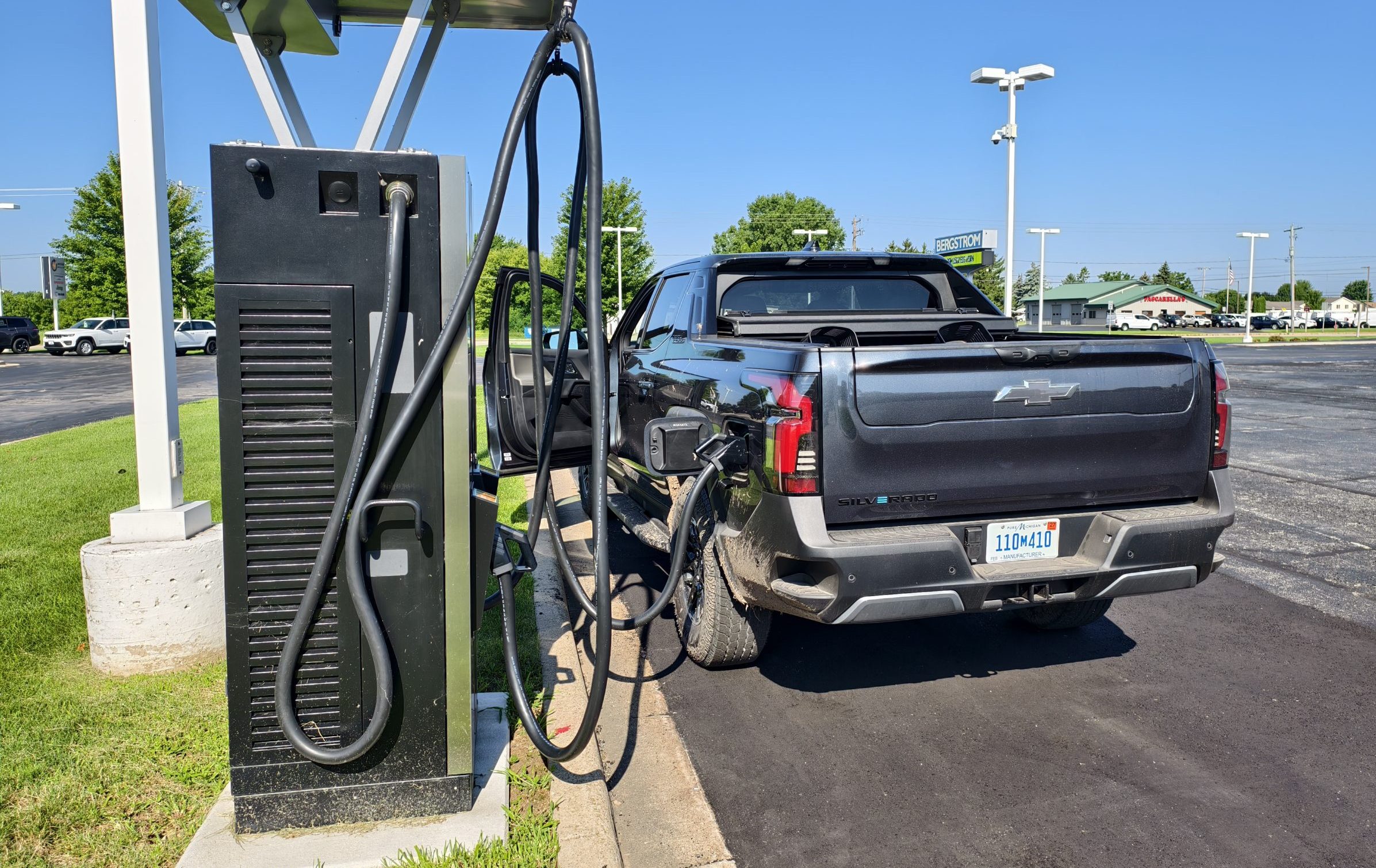
The drive home was much more challenging, as the temperature was above 90 degrees and there was a wicked crosswind. On that trip, the truck averaged 0.7 miles per kWh for about a third of the drive. That 0.7 mi/kWh even included having to slow down to between 55 mph and 60 mph due to traffic. Things got much better in Milwaukee, and I was able to increase speed back to 65 mph to 70 mph while efficiency rose to 0.9 mi/kWh. That time, I arrived home with 22 percent charge after consuming 70 percent of the battery, which included air-conditioning, which used a little over 2 kWh of juice.
When it did come time to charge, I was impressed with the charging performance of the Silverado EV. Assuming that you can find a properly-equipped charger, the Silverado EV can suck up to 350 kW of juice. The fastest charger I found in Oshkosh put out 178 kW. I plugged in with 8 percent remaining, and after about an hour and a half, the truck’s battery was back to 100 percent.
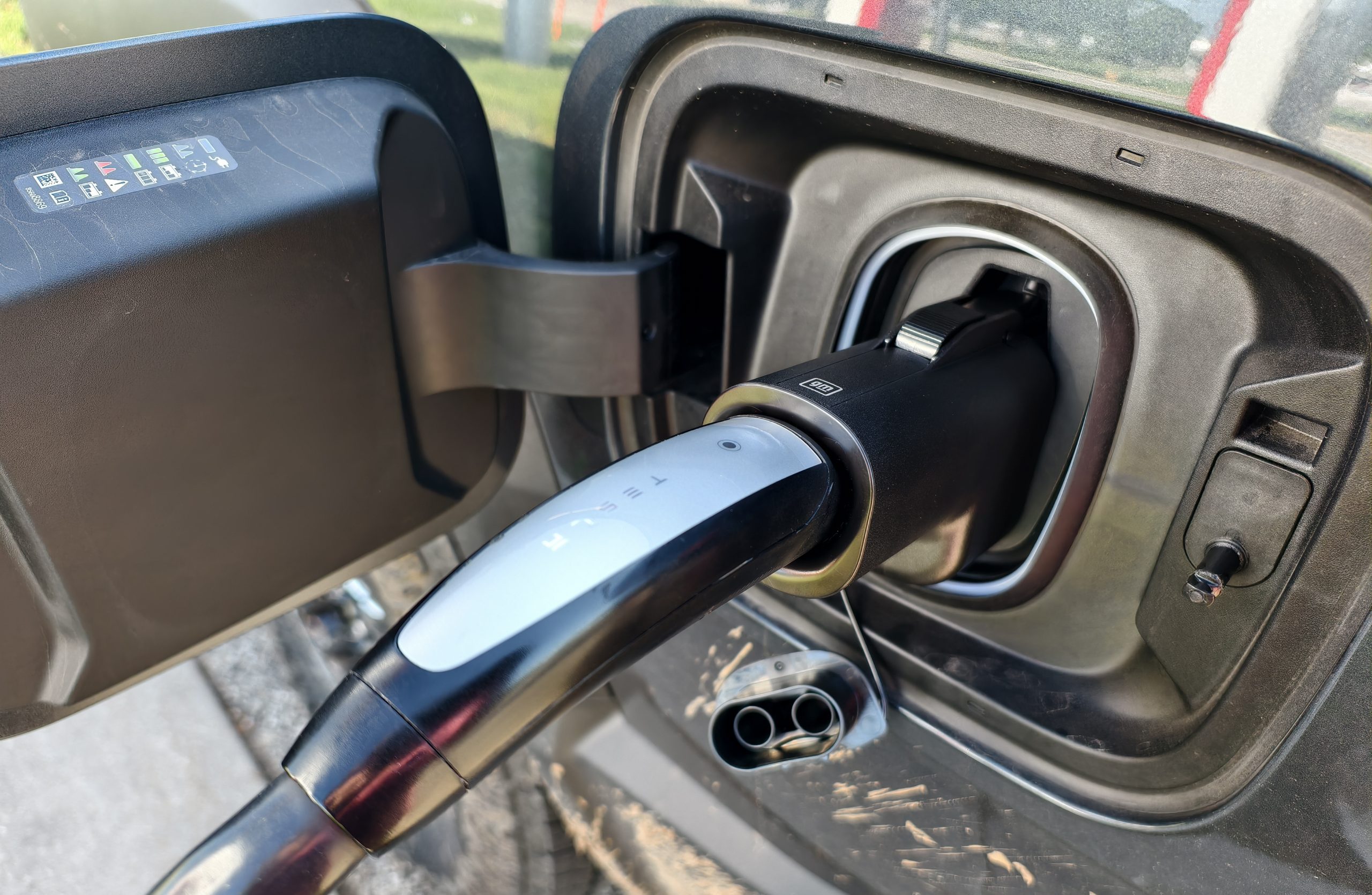
GM provided me with an NACS adaptor, which meant that I gained access to Tesla Superchargers. These had a knack for starting out at around 178 kW, but then quickly throttling down to 60 kW before recovering back to 70 kW. This is a common issue with charging GM EV trucks on the Tesla Supercharger network, and means that if you have the choice, go somewhere else to top up. Otherwise, don’t be surprised if it takes a couple of hours to get enough range to start towing your trailer again.
In terms of charging costs, running the Silverado EV cost me about as much as running a big gas truck would. I spent $133 at three Tesla chargers, getting a total of 268.32 kWh of energy. I then spent $82.11 on other charging networks, for a total of $215.11. Sadly, my receipts didn’t show what energy I got from them. However, I do know that I drove the truck about 600 miles in total. In other words, the truck cost me just under 36 cents per mile to operate.

For comparison, I averaged 10.2 mpg towing the family camper with a Ford F-250 Super Duty Power Stroke. Based on its 34-gallon tank, that means a range of 346.8 miles, or a little less than double what the Silverado EV could do while towing the same trailer. That truck would consume about 58.82 gallons over the same 600 miles. At current diesel prices in my area, which are about $3.80 a gallon, that adds up to $223. So, the Silverado EV is about as expensive to run on public chargers as a diesel truck.
Like A Diesel, But Quiet

I even did some mild off-roading with the truck, as the camp at AirVenture got seriously muddy. The Trail Boss rode through soupy mud like it was nothing. Now, I have no doubt that this truck would struggle with crawling over rocks or through terrain serious enough to warrant lockers, but mud, fire roads, and mild to moderate terrain? Yeah, the Trail Boss could handle it.
Even with this truck’s faults, I was thoroughly impressed. It was freeing to be able to take a long-distance trip in an EV without worrying about running out of charge. I was blown away by the truck’s diesel-like towing performance, soft suspension, and library-like quietness. General Motors did its homework with this truck, and I think it makes a passing grade.

But the truck doesn’t get a perfect grade. I cannot discount the problems that I experienced with the truck’s interior fittings and with Super Cruise. Then there’s the price of it all. The 2026 Silverado EV has a base price of $54,895, which isn’t bad until you realize that it gets you a work truck with few features, rear-wheel drive, black bumpers, and steel wheels.
If you want some style, that’ll cost you $62,995 to get you into the LT. If you want a Trail Boss with the Max Range battery like the one I had, that one starts at $88,695, and then escalates with options. According to my press truck’s window sticker, the folding tonneau cover was $1,850, then other additions included a $1,800 glass roof, and a $1,495 tailgate with a step and an integrated Kicker boombox. The end price? $93,940, which includes a $2,095 destination charge.
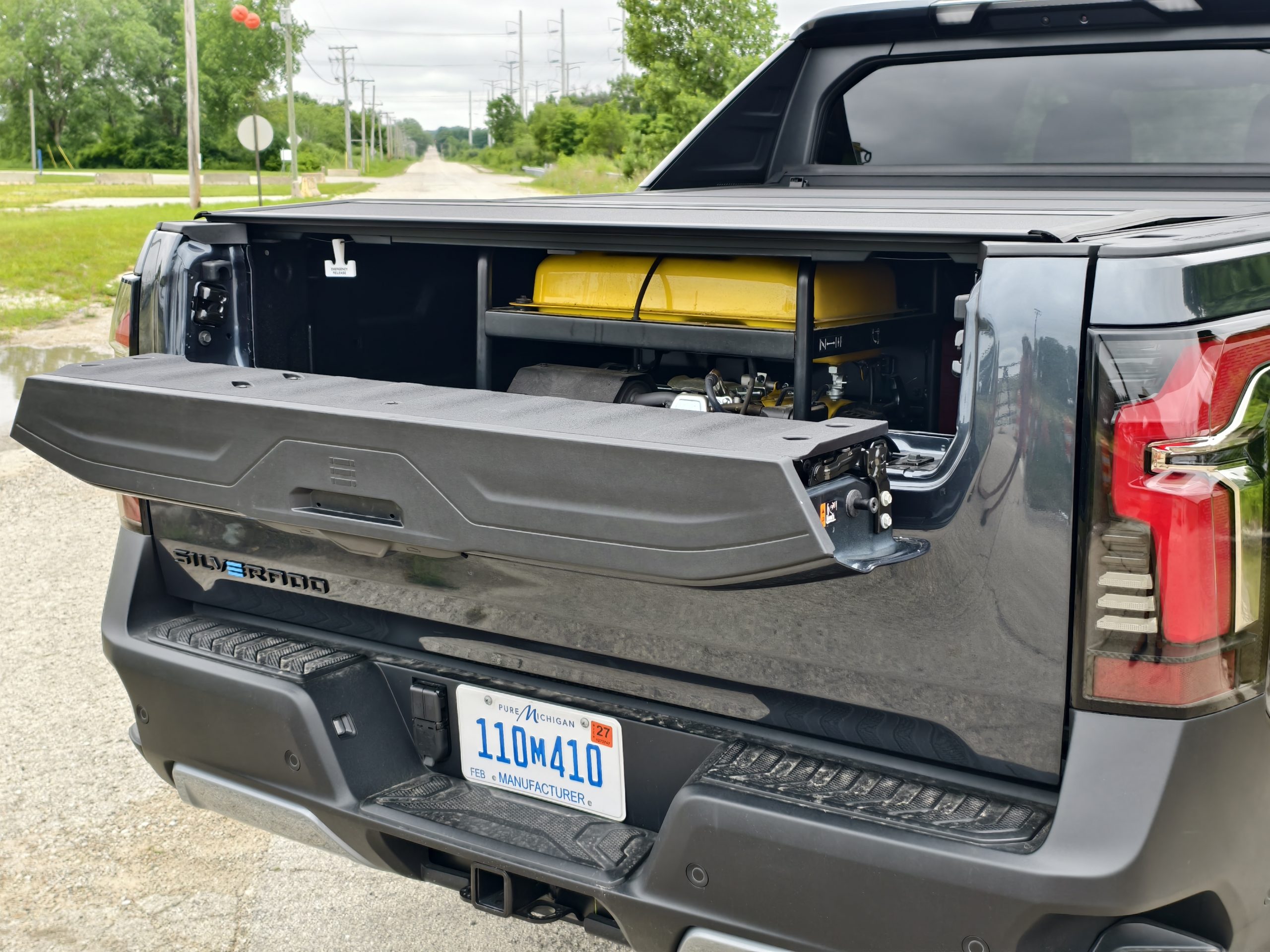
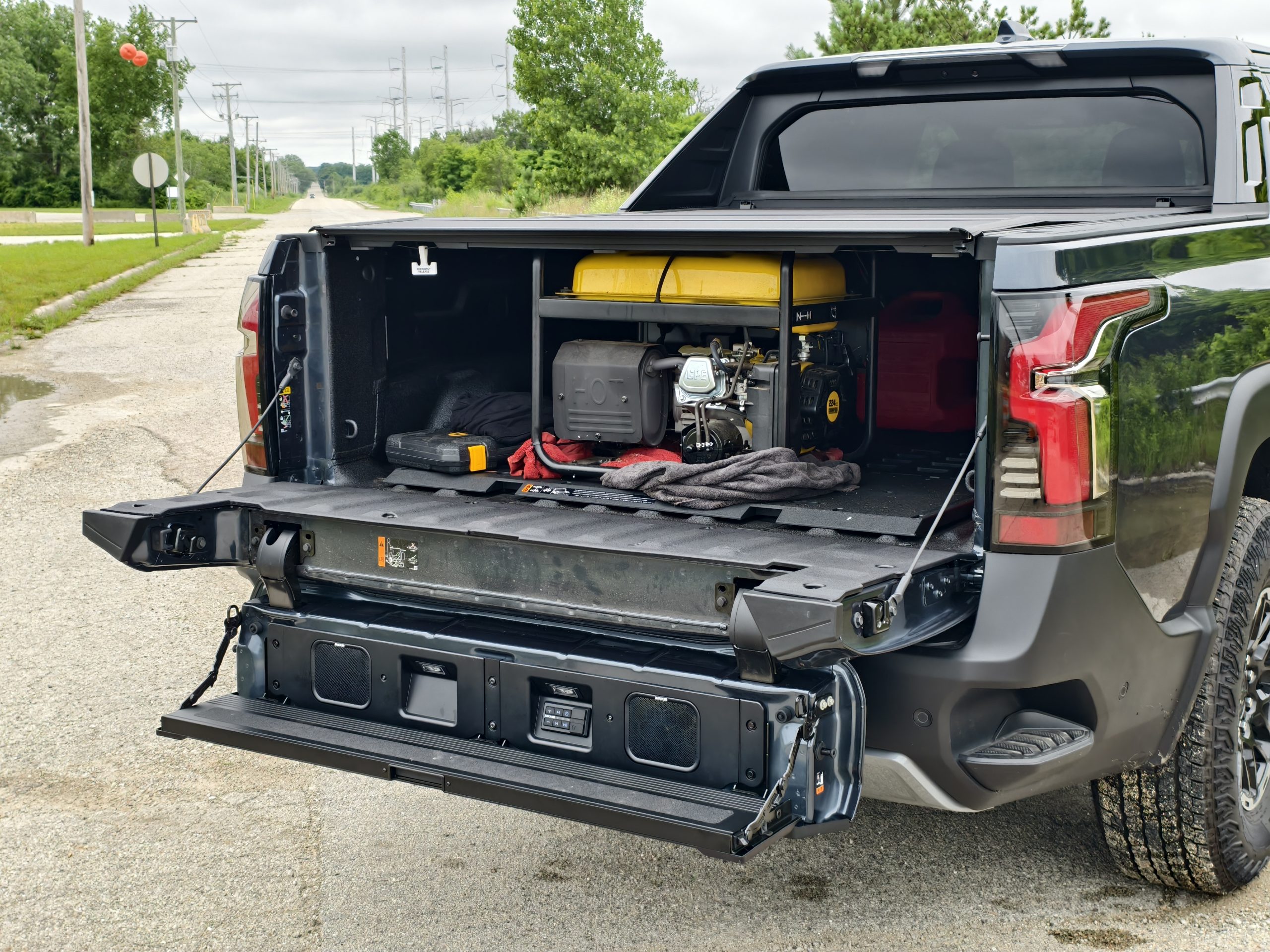
To put that price into perspective, that kind of dough would easily buy you a Ram 2500HD heavy-duty pickup with a Cummins diesel engine, with nets you significantly better payload and towing capacity. That said, you can save on a Trail Boss by getting one with the smaller Extended Range battery, which is good for 410 miles for $72,095.
To me, the biggest problem with the Silverado EV is not the truck or its price, but the infrastructure that supports it. This is a truck designed to tow trailers long distances, but America’s charging network isn’t yet built to handle people who use EVs for work or for towing. Nobody wants to decouple from their trailer every single time that they need to charge the tow vehicle.

America’s questionable charging infrastructure also harms innovative camper trailers like the Pebble Flow and the Lightship AE:1. If you cannot easily charge a truck while it’s connected to a trailer, imagine the headache of trying to charge both your truck and your trailer at the same time.
This puts the Silverado EV in a weird place. In some ways, it’s better at towing than a diesel truck. Certainly, EVs flex their towing muscles without fumes, diesel maintenance, or diesel pollution. But charging sucks so much that it’s easier to keep burning fuel, anyway.
So, I think the best way to describe the Silverado EV is that it’s one of the best trucks for a future that isn’t here yet. It’s a towing beast, can outrun darn near any gas-powered vehicle in a stoplight drag, and is the first electric truck that I’d feel comfortable driving across the country. In short, it rocks. But America just isn’t ready for it yet.
Top graphic image: Mercedes Streeter

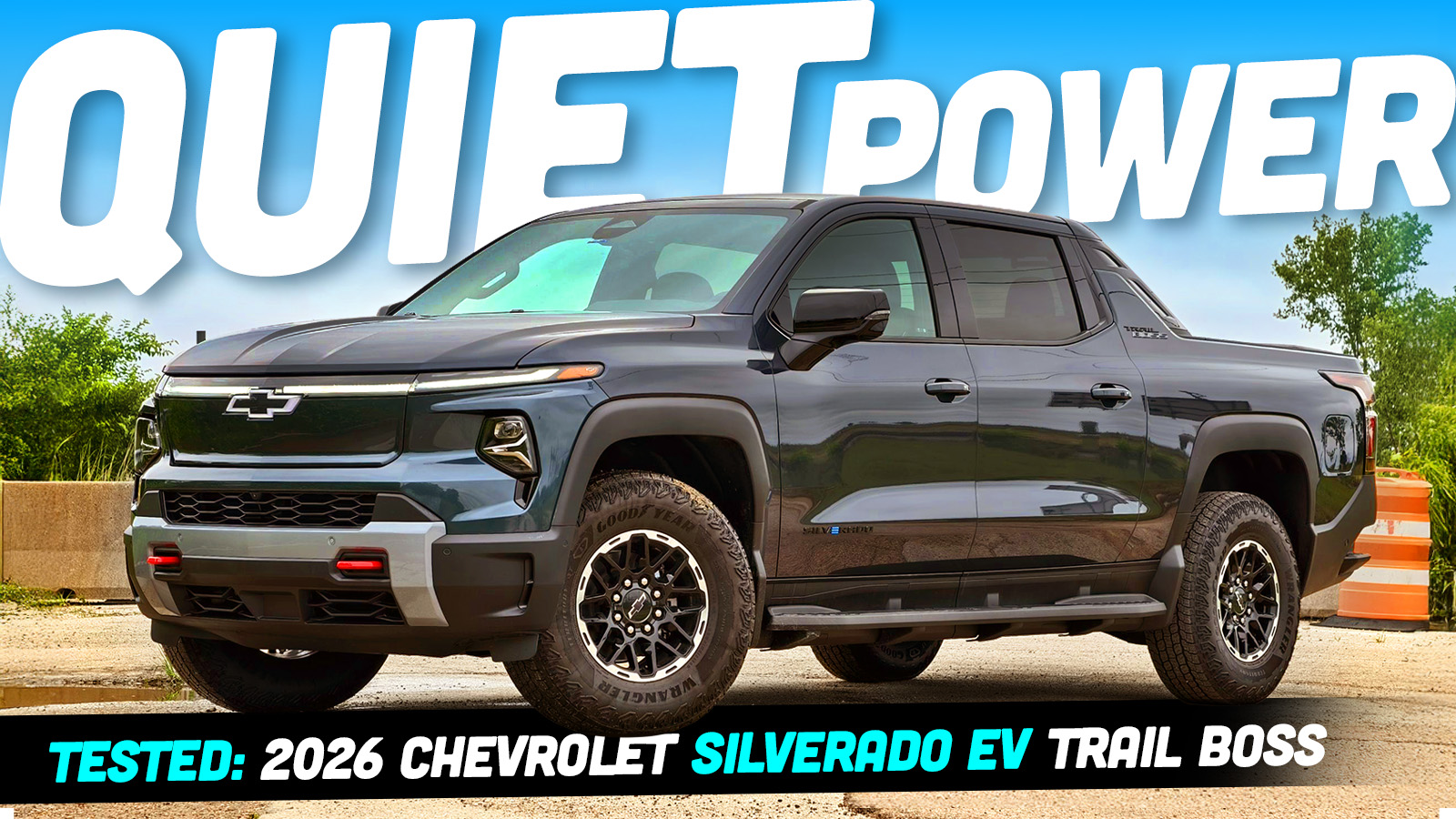







Good review. I just (last week) bought a new 2024 Silverado EV 4WT that was $20k below list with dealer markdowns and incentives. I love it. I’m looking forward to towing with it and have already found a few pull through chargers.
IMO, if you’re towing, the WT is the one to get. You give up a number of frills, but you get Carplay, excellent range, a surprisingly good turning radius even without 4WS, and IMO also better tires for everyday truck uses. Of course, I think the price I paid is about what it is worth. There are still 2024’s around but not many. Some 2025 WTs have significant markdowns.
One video online echos your statement: it’s not range anxiety, it’s charger anxiety.
My own experience with Tesla chargers is they seem to have communication issues with the truck through the NACS adapter as it give me a very bizarre range reading after I charged at one. Plus some of the chargers I couldn’t fit into the adapter. I had to move to a different station to find one that worked.
Now I’m trying to find full-size-ish lightweight trailer that has a bunkhouse for my kids and a queen bed for my spouse and me. I am seriously considering a TrailManor but I don’t think the idea is as refined as it could be (you have to hang cabinets when you raise it up).
I personally think the real solution to towing is for affordable (natch!) travel trailers that have battery assist and/or even motors in their wheels. I know Airstream did that, but something like that needs to come to production.
I’ve already bought a backseat airbed for the truck so I can sleep in it when I’m alone. (I have to travel sometimes) I’m looking for a good 12v freezer/fridge for the frunk, and ideal accessories to plug in: perhaps a compact microwave!
Edit: Also, I tried an RST with SuperCruise but it was “super” finicky. I think it’s a great idea that will be working better in a year or two. All I know is that Tesla’s don’t disconnect FSD when they “see” a construction barrel, but the SuperCruise does that by design. By chance I was in a place with construction all over and I just shut it off because it disconnects so suddenly that I swear it could easily cause a wreck!
Ok sorry this is going to be long but I don’t understand the conclusions of this article and am afraid it will mislead unknowing people into thinking this is a worthwhile vehicle.
If this is a vanity project, it makes sense but only as that. And that’s what the HummerEV is, did GM really need to come out with 2 others? The only use case for this is for Electric companies, and that’s a whole half of the 6 I’ve witnessed in public over the last year. They’ve been owned by in the Chicagoland area, badged as ComEd vehicles.
This vehicle is a waste of resources, dangerous on roads and completely not worth the money charged. Not even counting that most people are not capable of handling a vehicle that fast/heavy safely.
For context and basis I own the spec comparison to this vehicle, just from 20 years ago. I have a couple 1500HD LT Quadrasteer. They retailed in ’03 for $45k (a lot back then, I didn’t buy either new), tow 10k, payload just north of 3k, crew cab 6.5 bed with rear wheel steer. The truck weighs about 7000lb empty, it’s equivalent minus the screens and driver aids. I tow anything from our car trailers cross country to construction equipment and materials locally that max out the trucks capacity.
You’re saying this is a fine truck and the ‘infrastructure’ is the only problem. This truck is just an electric version of what they made 20 years ago, for more money, less quality interior (I’ve seen them in person) and runs on electric instead of gas.
The only use case is if you’re not going to use it as a towing rig, or you’re retired and don’t care that any decent length towing trip you take is going to take at least 50% longer, assuming you find a charging station working and open every time you pull up. If I have to wait at a pump it’s no more than a few minutes, I’ve watched people wait at charging stations in a line for over half an hour to then have to sit there for half an hour to charge, in a car that at best gets them a couple hours of driving. This thing would be much longer than that.
I’m also going to give the benefit of the doubt that the SuperCruise worked well 99% of the time and not 95%, but even that, if my vehicle tried to wreck me 3 days every year for no reason I definitely wouldn’t be ok with that. Even slamming on the brakes at highway speed, if a small car is behind you that’s a serious accident for them since your rig weighs so much.
This thing is also going to absolutely destroy tires. And those tires are not cheap (I believed in another discussion I looked it up and they were around $500/tire, hopefully they’ve come down some since).
And the comment on ride quality, I should hope a 9000lb truck rides nicely. Even my truck that’s 20 year old tech and on a 3/4ton chassis rides pretty nice if I added another ton on it.
You were towing at 65 and 60mph? That is honestly an unsafe speed on almost any highway I’ve driven on. I just took a couple thousand mile road trip on i80 (70-75mph) and the semis were doing just that or above. If I had hundreds of semis coming up behind me and passing at a 10-15 mph difference I wouldn’t feel comfortable. I’m sure this truck could do faster safely, but then you’re efficiency is probably worse than an ICE truck.
And all this so you can have at best the same efficiency as what we already have infrastructure for? This is a horrific use of resources. I’m by no means an environmentalist but I find it hilarious how inefficiently they are going about ‘saving the planet’. Why take one truck and make it slightly more efficient than it’s gas alternative (assuming your electric comes from clean sources and your time is worthless), when you could take that same size battery and build 10 EREV that are even 20% more efficient than straight gas and save the equivalent of 2 trucks. Or use the batteries in several electric cars or even better a ton of hybrids.
In the end the battery technology is not advanced enough to justify fully electric cars. The damage and production and potential danger of current chemistry is perfectly suited to PHEV or EREV, which could potentially cut out well over half of light vehicle gas. They should have taken steps to get to fully electric but no one can be pragmatic or patient enough to work toward something, they just want it all now and then when it doesn’t work everyone gives up and gets upset.
This is one vehicle GM should actually fail at because it’s just a bad combination. They normally ruin great ideas with bad marketing but I’m hoping this one ends up where it should with no sales so they will actually try to make something practical instead of throw this thing together and watch suckers buy it. I’m a lifelong Chevy guy, The 3 guys in my family currently own 13 GM vehicles spanning the last 55 years so it’s not a brand thing either.
Sorry if this turned into a rant, I didn’t mean it as such but I would honestly like to know the justifications to the issues I’ve experienced above and it’s not all written off because it’s something shiny and new. (and that’s not a dig, I love shiny and new and get wrapped up in it quite often until I sit back and reassess it).
Much of your comment is addressed by the fact that, as I noted in the story, you can buy a three-quarter-ton diesel truck for the same money and get a better tow rating, a better payload, far better towing range, and similar fueling costs. Mind you, this is technically a half-ton.
However, if you want to do actual truck stuff with an EV, this is it. None of the other electric trucks on the market, including the GMC Hummer EV, can do what this truck can. And yep, it’s still compromised, as I noted.
My comments on ride quality are based on the truck in an unloaded state, so comparing it to a 1500HD with a ton of added weight in it doesn’t make much sense to me. Weight alone is not the only determining factor in ride quality.
This truck does not use the same suspension as the gas half-ton, nor does it use the air suspension of the other Silverado EV models. It’s pretty common for the off-road model of a truck to ride harsher, especially when unloaded. This was the case with the Ram 2500 that I tested earlier this year, and it is the case with the F-250 that I’m testing now. The F-250’s ride is shockingly harsh.
This truck weighs as much as some modern heavy-duty pickup trucks and has a significantly better ride. I think that was worth noting.
I just drove to Baltimore and back and spent much of my time waiting behind pairs of semis where one had a top speed of 70 mph and the other a top speed of 69 mph. If only these trucks were going 75!
At any rate, on both the departure and return trip I was following roughly the speed of traffic in the far right lane. Usually, I was following another camper or one of the slower semis. There were even times I had to slow to 55 mph or 50 mph due to heavy Oshkosh camper traffic and road construction. It was fine. I have driven thousands of miles around and across America in trucks and buses that had cruising speeds around 65 mph. Everyone moving at a faster pace managed to see my giant vehicle and passed accordingly. Again, far right lane.
However, you are correct that I could have switched into the left lane and gone much faster, and there were periods in which I did hit 70 mph or more. Admittedly, I probably could have done my whole trip at 70 mph, but since the range estimator was not working correctly and I didn’t trust my math, I didn’t want to take unnecessary chances. But still, it was fine.
I get what you’re saying but I guess am still missing the comparison. This is a more direct comparison to gas, not diesel by numbers. Towing a max of 10k. If you’re saying just in relation to acceleration I guess you could say diesel but a gas with tune would be close to the same at 10k I get that it is still quicker but with that behind by my gas truck has never been a problem for me speed wise. Diesel hasn’t been limited to even 12.5k in almost 30 years. And this cannot have a gooseneck system in it since it’s a connected bed correct?
For ride quality, I’m making that comparison because the numbers are identical. If Chevy stuck 2000lb under the bed of my truck it would ride nice all the time and the payload of the trucks would still be identical, so in my mind that’s basically what they did right?
And I guess I’m used to the ‘mad max’ i80 by me, I was on it this morning and the semis were cruising at around 70-75, 2 car lengths between them max with cars swerving in between them, speed limit is 55. It’s fun, They came up on a car probably doing 60 in the left lane and they almost got rear ended several times if not for semi’s braking hard, it’s run.
And yeah the GM range estimators are not great. I don’t understand how they haven’t made an adjustment to factor in current MPG more quickly. Doesn’t Ford Lighting sense the trailer hookup and basically kick the estimator into a different calculation? Doesn’t seem that hard to do GM.
These crappy trucks weight way more than 750kg. You should check their weights next time
This truck weights over four tons and drives like a midsize truck. It’s very well made. I don’t think it’s dangerous or a waste of resources. I own one. I’ll never go back to ICE. The video Mercedes referenced above includes a comment that while towing the efficiency exceeded an ICE F-150 that was unladen. This shows how awful ICE engines are at their efficiency. Even a 4T truck is better for the environment. Mind blown! Other research confirms this for entire lifecycle emissions.
Of course, big trucks are always worse, but presumably, you’re not buying them for a vanity projects (of course a lot of people do), but I bought a WT for going into the mountains and for towing.
Are you saying current midsize truck? (IE the ones larger than full size trucks a couple decades ago, but with less capacities?) I can see that since most of that weight is under the body. But most people cannot control the speed/force of 4 ton getting to 60 in less than 4 seconds. I’m all for that, I’ve grown up with crazy fast cars, but I also spent a lot of time honing the control of them. I highly doubt anyone will do that with what’s sold as a daily driver. And the ‘safety systems’ don’t inspire a ton of confidence from my experience with them. They work well sometimes but if that’s what you rely on it only takes one time of not knowing what to do and it becomes a very large problem.
And I greatly question the ‘lifecycle’ estimates of these. I get that they might be slightly better, which my point is there are a lot of other models that are much better all around and that’s where limited resources should be going, not something that only is better in limited situations. My questioning of the life cycle is are they factoring the amount of these that are going to be totaled at a young age because the battery pack is damaged or they got into what would be a semi-serious accident in an ICE car where they change out parts. The benefit of electric vehicles is also a risk in that they’re simpler but the few main components cost much much more.
I’m all for electric cars, I just think at this point they need to be focusing on hybrid/PHEV to actually reduce overall fuel usage, then when the next big battery step comes they can make BEV. The next big step should result in a good range and not having a car that weighs more than a vehicle 3 sizes bigger which will be much more efficient, less force in an accident and less wear and tear on infrastructure.
“Literally Mercedes Streeter.”
About to tell us all about SPACE PANTS:
https://m.youtube.com/watch?v=MwpmqMnngRk
I happened upon one of these things being towed down the interstate a few months back. It was going rather slow, and I was in a hurry to get past it. To my amazement, upon finally getting ‘my turn’ to go around it – it was being towed by an F-150 Lightning. I really wanted to know what kind of mi/kWh they were getting towing a 13.5′ bluff wall down the interstate.
https://www.campersinn.com/product/new-2024-coachmen-rv-catalina-destination-series-18rdl-2442907-3
https://assets-cdn.interactcp.com/campersinn/unit_photo/imgh_800x600-wm_campersinn_com-m0618202419202231/unit_photo_202406180720223146012781.jpg
That’s one way to double your range.
Sorta.
When I had a Silverado EV RST as loaner for a month, my electric bill went almost double compared to charging my Blazer EV. What I used on a round trip on a regular commute, the Silverado was using the same just one way there. GM created a legal monster truck that nothing can stop it either towing or flooring it when merging on the highway. It’s impressive how technology has evolved, this truck is peak GM, including interior half done lol mine also had the same stitching issue.
That sounds about right. On one hand, still more efficient than virtually all ICE vehicles, but pretty lousy for an EV. Still, so nice! (I just bought a 4WT)
Great write up but yeah, having nearly 3,000 lbs of batteries is not the answer, the batteries in this weigh almost as much as my entire Ranger Electric, granted 25 year old batteries have 1/8th the range, but modern batteries same weight could get it to at least half the range of the Silverado.
Agree with everyone here saying plug-in/extended range electric is the answer for long range towing trucks, and the first to come out with one gets to claim the king of EV towing title from Chevy, range extender is not a cheat on something this big.
Also fit and finish is really disappointing at the price point, and especially for a press loaner for reviews, but considering the stripped down W/T starts at mid 50s that’s not too big a shocker.
The Rivian R1T Max Pack is just under 6000lbs. This is with a 141kWhr battery. The Silverado EV 4WT is 8532lbs with a 205kWhr battery for about 70-110 miles of real world range (R1T range tests show it never hits its stated range, while Silverado EV usually does.) So over 1ton for 15-25% range increase. This seems to show the limits of battery size.
That said, I am pretty sure the Silverado EV could be made 10-20% lighter, it’s just it would drive the costs way up.
I think there’s an argument for range extended PHEVs but I don’t think it’s a panacea. The proposed battery sizes for RAMs suggests excellent use for daily driving but I think towing is going to be the same dilemma. With a heavy load you’ll get about 80 miles at best before the range extender kicks in and then what? That V6 will be working overtime to keep up with the load and then it will start to feel as though you are not driving a very efficient truck compared even to the Silverado EV.
I’m a bit biased though–I just bought a new 4WT for $20K under list. I love it…and it drives like vehicles half its size and a third of its weight. And so much mechanically simpler. You are trading weight for complexity. And I already have found multiple 350kW pull through chargers in my area and on routes I normally take. Charging infrastructure has dramatically changed even within the last 12 months. 20 minutes to add 200 miles. I walked into the store where the charger was (a normal truck stop with chargers on the side) and was listening to a guy on the phone trying to get a new alternator overnighted to him. Yep.
If you’re towing a heavy load, you should have the range extender on the whole time so that you’re using the drivetrains as a pair, rather than individually, allowing them to individually be smaller than a normal-sized drivetrain for a BEV or all-ICE vehicle.
If anything, you keep the engine running until you know you have plenty of electric range to reach your destination/charger, and THEN turn off the engine.
We’ll have to see how that works, for example the Silverado EV just assumes trailering will half the range and up the torque when you hit the trailer mode. But if it’s a range extender in the strict sense (and the motors, not the engine, are what’s powering the wheels as described in what’s been released so far), then it definitely not be the most efficient arrangement. But the engine control will most likely be out of the direct control from the driver.
If they’re smart about it (what are the odds?) they’ll have a tow mode that reserves the pack for helping the range extender, like how the original Volt had mountain mode.
Exactly. I believe I’ve read that it will have such a mode. It should also react to whatever is put into the navigation because otherwise people will drive to the point of emptying the battery and then act surprised that the generator can’t tow a 10,000lb trailer up a mountain at 75mph indefinitely.
With the super cruise being finicky can you turn it off and just use ACC? So it keeps your speed setting but will slow down/speed up depending on traffic. As reading this it seems I would rather just use adaptive cruise vs Super cruise deciding what it thinks is right based off signs it thinks it is reading.
I hope so. I have a WT with only ACC and lane keeping assist and it’s basically everything I need on the highway.
I am due to get a new work truck, and I really like these, but i can’t imagine the wear on the wheel bearing and suspension components. Also, the price. If someone would just come out with a EREV pickup with 150 miles of EV range.
I guess hold out hope for that new Scout erev that David tracy is all hot and bothered about
Damn another great article very informative I was doubtful of the America not ready but sure enough we aren’t. My only thought I may have missed it if you covered it. Has any studies been done rating the economics of tossing in a few hundred more pounds of batteries instead of a gas powered generator or two? I think a hybrid option that could charge up the batteries while driving extended range that way and the option carry a few gallons or stop at a station for fuel could get you to a charging station when the hey can I borrow a few kwhs of electric power to get to a charging station? You aren’t carrying a full ICE motor but a truly proved a gas driven electric generator
I guess I’m not sure why manufacturers keep trying to shove square pegs into round holes. Road tripping tow pigs are one of the last usage models that full electrification should be trying to address, although I sure do wish my Suburban could be a plug-in hybrid.
I think its because big pickups are one of the 2 or 3 types of vehicles Americans still buy, or that automakers still bother to try to sell to Americans, either way, so the thought is that if you really want to sell EVs, you have to make one
Also, pickup buyers have proven themselves willing to pay ridiculous MSRPs, marked up beyond any relation to what the vehicle actually cost to develop and manufacture, so it seems like a good way to cover the extra costs of an EV
I think plug in hybrid is the better answer. A friend has the F-150 where the engine works as a generator and can charge your camper battery. It is amazing and gets relatively good fuel economy.
The other question I have with this thing is tires. With that amount of weight are there good tire options available?
Yes, but only because 1ton pickups exist.
Also view load ratings as my truck had 35psi max on the sidewall but 80psi on its load rating chart. So stick to 35psi around town, 80psi if “needing” its max rating. Like towing a trailer with a heavy nose.
Your tire is marked with 35PSI Max, yet you’d consider filling them up to 80PSI because the load rating chart says so? I don’t think you have the right tires to be utilizing that maximum load rating. 🙂
Just assumed 35psi was for idiots who filled it to max since the marked load rating could only be hit at 80psi. Note I looked up the specific tire not generic. Never blew a tire.
The charging infrastructure thing is still a bummer. The fact that every single EV review or Tube video STILL has to dedicate a significant amount of word count to how much of a PITA charging continues to be is not a good sign. I mean, the fact that EVs have now been pretty commonplace for nearing a decade and this is still such a significant issue is not going to help the adoption rates.
I wonder if China or Europe have similar issues with their charging infrastructure.
It’s really not a big deal anymore for the large majority of trips if:
-You’re not towing
-You have access to the Tesla Supercharger network (which most EVs do, now)
I’ve done ~15 trips of ~1000+ miles in 5 different EVs and it’s just not a big deal anymore once people get their heads wrapped around partial charges being optimal vs refueling to full.
Not to say it’s “just as convenient as gas”, necessarily, but it’s not the wild west like it used to be.
I get ya, but most of my road trips do involve towing so that’s where my head goes. And what seems like a high prevalence of unreliability from a lot of non-Telsa chargers. For my pedantic self that adds up to death by a thousand annoyances.
This is why I’m drinking the David Tracy kool-aid on REX trucks like the Ramcharger and new Scouts (if and when either of those actually happen).
Yep, it’s still notably more planning/annoyance to tow with an EV, substantially because of the problem of finding a place to charge without unhitching the trailer.
If someone’s use case is rarely towing longer distances, then unhitching the trailer once or twice a year is objectively not a big deal, but yeah, if you’re constantly doing really long towing trips, then it could be annoying.
Does the Silverado EV have the ability to act as a power station? Would have been a good way to avoid the generator noises at night (assuming you had enough range to do so).
In a similar vein… could your generator have been used during the day to recharge the Silverado EV?
It does! However, I did not have the proper adaptor to connect the truck to the trailer. Also, knowing my parents’ heavy power demands, they would have definitely zapped the remaining 28 percent charge in no time.
28% of an over 200kWh battery is a LOT of energy.
I ran the essentials of my *house* for 5 days from a battery less than half this size, using 10-15% per day. So, maybe 4-7% per day of this size battery.
Knowing there are 17,000 lb rigs travelling 70mph on their own is frightening, but I’m glad you tested it. Smells seeping in the cab and lingering is unacceptable if you plan on picking up a little mulch and fertilizer which is all most people will load in the bed.
I see what you’re saying, but I think America is ready for a good EV truck. They just aren’t there yet.
I tow a small popup camper with a Model Y. Everything about towing is so far true. Range gets cut in half and dropping the trailer is the most practical and socially acceptable way to charge at pull-in chargers. The MY is rated at 250 watt-hours per mile, or 1 kWh for every 4 miles. Towing spikes that to 450-500 wh/mi, or 1 kWh for about 2 miles.
Also, can you please report energy consumption in watt-hours per mile (wh/mi)? That’s easier to compare across EV’s with lower being less energy used.
What’s the GCWR? At 9000 lbs empty,You have 16k of cargo/towing room before you get over 25,999lbs.
“So, the Silverado EV is about as expensive to run on public chargers as a diesel truck“.
What a coincidence! Or, maybe electric charger companies carefully adjust the rates… FWIW, chargers on the NJ Turnpike (Applegreen) charge about twice the residential cost/kWh ($0.40 v. $0.17 – 0.18). Of course, there are fixed costs, such as for equipment, that must be accounted for. While charging at home, EVs save money, but on the road, apparently not.
Well, it’s retail vs wholesale. At home, charging is wholesale; at public chargers, it’s retail.
When we had our own 1000-gallon tanks, fuel was a lot cheaper delivered than at the gas station.
For the delivered fuel, are you talking about diesel for ag use?
Diesel, low octane, and high octane gas.
We had tanks for ag and road for all but the high octane.
The road fuel was still a lot cheaper. We would get audited occasionally.
Did some of the ag fuel get used on the road? Well sometimes, but it was between different fields after I-5 cut through the property so there was some sort of exception for that.
Simerlary, my friend in the Hudson Valley has a field in the north fork of Long Island and one near Rochester, so he’s almost always between farm properties and technically legal in his farm trucks wherever he goes.
From my limited experience, the price difference between that fuel and what you get at the gas station is almost entirely taxes. Gas stations almost never make much money on the fuel, 5-10 cents/g.
I wish I was paying wholesale electric prices at home. I think you mean “Residential” vs “What the market will bear” at public charging stations.
Yes, not the reseller rate, but the purchasing in large amounts vs small amounts. I realize that wholesale often means for resale, but I was using it in the large vs small transactions sense, and owning some of your own infrastructure sense.
It’s all what the market will bear in most cases anyway.
Also tesla tries to get you to subscribe monthly to lower what the rates are. From what I read it does pay itself off if you charge on super chargers ~4 times in a month
It would pay for itself after a single charge on this truck, I bet. It’s usually a 25% discount. If the base price is ~$0.50/kWh, it would save ~$0.12/kWh to have the membership. The membership is $13/mo, so if you charge ~100kWh, the membership has paid for itself, and this battery is over 200kWh.
205kW. That’s ridiculous.
I’d like to think EV technology is approximately at the same spot electronics companies were when the VCR first came out and this will eventually be looked upon as an anachronism.
I would be nice to compare to a gas (or diesel if available – I’m not up on trucks) towing range. Comparing to other EV trucks is useful, but if someone is shopping for one of these I think they would want to know that info too.
As Mercedes said early on, the efficiency is the issue on both sides. So it really depends on what you are pulling. A low profile trailer with a lot of weight? Not really going to drop the range that much. But a blocky trailer?Pulling that trailer sucks down range like crazy, in both gas and electric trucks.
Both will suffer similar, but the gas trucks have solved this by having two tanks, and the infrastructure to be able to fuel up in a short time.
Good point. I just added this to the section that mentions the diesel F-250:
Thanks!
I really don’t want to be the old guy I’m becoming, but 100k for a truck? A truck. That’s just crazy to me. I would rather just buy an old used Avalance for towing and save the other 95k for literally anything else. I get that this is the state of vehicles today, that every stupid thing is that much more stupid expensive, but for some reason (again, probably just old guy shit), but that’s just a rubicon I can’t cross.
100k and did you see that interior? I noticed the awful stitching in one of the first pics and then Mercedes mentioned it later. I do like the exterior at least.
I live in the truckiest of truck states, you can’t throw a rock without it ricocheting off nine trucks to hit a tenth, but as spoiled for choice as I am I still haven’t seen a truck I would pay 100k for. I mean, this seems like as nice a truck (on the outside and performance-wise at least) as you can get, but I just can’t see it. I could happily outfit my family of 4 in some nice individual trucks for that amount of money
Ha well you’re not spending money on a nice interior. You’re spending money on $50,000 worth of lithium batteries.
It seems that maybe GM should design a skateboard with a range extender, and apply it to various medium duty trucks for people who don’t want to be tied down to charging stations. Smaller batteries and less powerful motors and some sort of engine to kick in when necessary. Scale up and modernize the Volt.
The other day I saw a Rivian towing an Airstream in a charging station blocking a whole row of other chargers. Good luck everyone else!
I hate separate up and down buttons for fan speed (it forces me to take my eyes off the road), but I don’t understand your suggestion to use a toggle switch instead. Both fan speed and blend mode would have at least 4 positions and most toggle switches are simply on or off. Just give me 3 knobs!
Rivian + Airstream = peak 1% attitude 🙂
The toggle could be up for a faster fan speed and down for a slower fan speed. It’s digital, so it’s not necessarily just on or off.
The mode switch would just cycle through the blend door options. Admittedly, my idea sort of sucks, too, but I tried to come up with a way to make the existing button bank work.
Gotcha. For some reason I way overcomplicated how a toggle would work for fan speed in my head and your suggestion totally works, but I dislike the idea of having to “scroll” through different blend options.
One could argue that a traditional rotary knob forces you to do that too, but at least with a knob I can go from one extreme to the other with a single 1 second twist of my fingers.
I ran into a similar conundrum when I rented a Cybertruck for fun during a break from a work trip in San Diego. I went from SD to downtown LA, recharged a bit from a free public L2 charger enough to make it back down to Irvine, then Supercharger from there back to SD and an top-off in the morning before I dropped it off again.
I don’t have the final number of fthe top of my head, but it was not much lower than if the 7.3 vantruck had made the same trip using CA diesel prices and its current known mostly-highway regime fuel economy.
Ultimately, I wrote it off to “The laws of physics largely dictate how much energy it takes to push a barn through the wind at highway speeds” as a 1980s van, a Cybertruck, and a Silverado EV with a portable hotel & convention center behind it are all barn-shaped objects.
I feel like the charging solution needs to be even more out-of-the-box than just the usual gas stations, hotels, and retail locations. The ultimate goal, whether real or imagined, is the ability to get off the highway and get into a charger ASAP, ideally with a trailer.
So there’s the obvious ones like truck stops or Buccee’s (which is basically a truck stop with less amphetamines and more pumps). How about KOA or other RV campgrounds that already have pull-through, full hookup sites? They could set aside a few of them just for EV charging and could even add a small upcharge for the convenience. Or maybe even roadside weigh stations and truck rest areas, which might require some loosening of regulations over who can use them, but it’d be nice to get a charge while also checking your weight.
It still feels like a bit of a niche, but as soon as the big rigs start needing it, I bet they’ll appear everywhere.
I’ve always thought that Bass Pro Shops (etc) would be a great place to put pull-through chargers at. They tend to be located right off of major interstates, have trailer-friendly parking lots, and there’s typically a lot of overlap in ‘people towing trailers’ and ‘Bass Pro Shop Customers’. Wouldn’t solve the problem, but, there’s enough of them that it could be useful to a lot of EV drivers with trailers.
Yep, that’s the kind of places who should be on board, they’ll get so much incremental sales from it (also any national or regional RV chains).
Funny you mention Bass Pro, our local Buccee’s shares an exit with Bass Pro, and it’s also the same exit for Barber Motorsports Park. It’s a critical mass of people, especially on travel or race weekends.
Oh damn, you live at Barber?!? I go there once a year to race with Lemons. Never been to the Bass Pro, but Buccee’s is a multiple-times-per-day affair because it’s so close.
Ugh, I cant imagine trying to navigate through the final circle of hell that is a Buc-ee’s parking lot in a gigantic, 2-story tall EV pickup with poor visibility, a huge trailer, and the low range warning going off as if it’s about to brick itself
Yes, I made my first visit to a Buccee’s on a Saturday in summer (near a national park, no less) and it was horrific. But on the plus side, they did have cones set up to separate large trucks/trailers from cars, then further between gas and store clients.
It was a real cluster, but if they put truck/trailer EV chargers in an outparcel in the parking area, I think it would work. The real key is keeping people engaged enough to wait for their recharge to finish, plus they could do like they do with gasoline — sell at a loss and make it up inside the store.
I attempted to stop at the one in Virginia last weekend, it was such a shitshow that I slowly navigated my way back to the Interstate and found the nearest Sheetz. I dont care how nice of a gas station it is, no gas station is worth circling the parking lot for 20 minutes looking for a space while dodging suicidal pedestrians who dart out randomly in large groups
I am in SWVA and recently experienced my first Buccees. We stopped at the one near Sevierville in TN last month on the way back from the Caverns. Gas was cheap, but my god never again. A huge for the sake of size convenience store stuffed with mouthbreathing people in awe of the enormity. WOW! LOOK AT ALL THAT JERKY!
Fascinating stuff. I admit I’ve never owned or driven an EV, but the range calculation not updating seems like something they should have solved before this ever hit the road. Am I overthinking it?
I still find this truck ugly. Those sail pillars just don’t do it for me. Otherwise, this makes a great case for why I might consider this truck when replacing my current one. If I was doing bumper pull, anyway.